Robert Textile Recycling Project
VerifiedAdded on 2023/06/11
|36
|8309
|69
AI Summary
This report discusses the urgency of textile recycling, the business development process, advantages of recycling, and more in Robert Textile Recycling Project. It includes a detailed discussion of the textile recycling process, sorting, and conversion of textile materials to new products. The report also covers the entrepreneurial sustainability in Nigeria and how Robert Textile Recycling can help in business development. The subject is IMA7002 and the college/university is not mentioned.
Contribute Materials
Your contribution can guide someone’s learning journey. Share your
documents today.
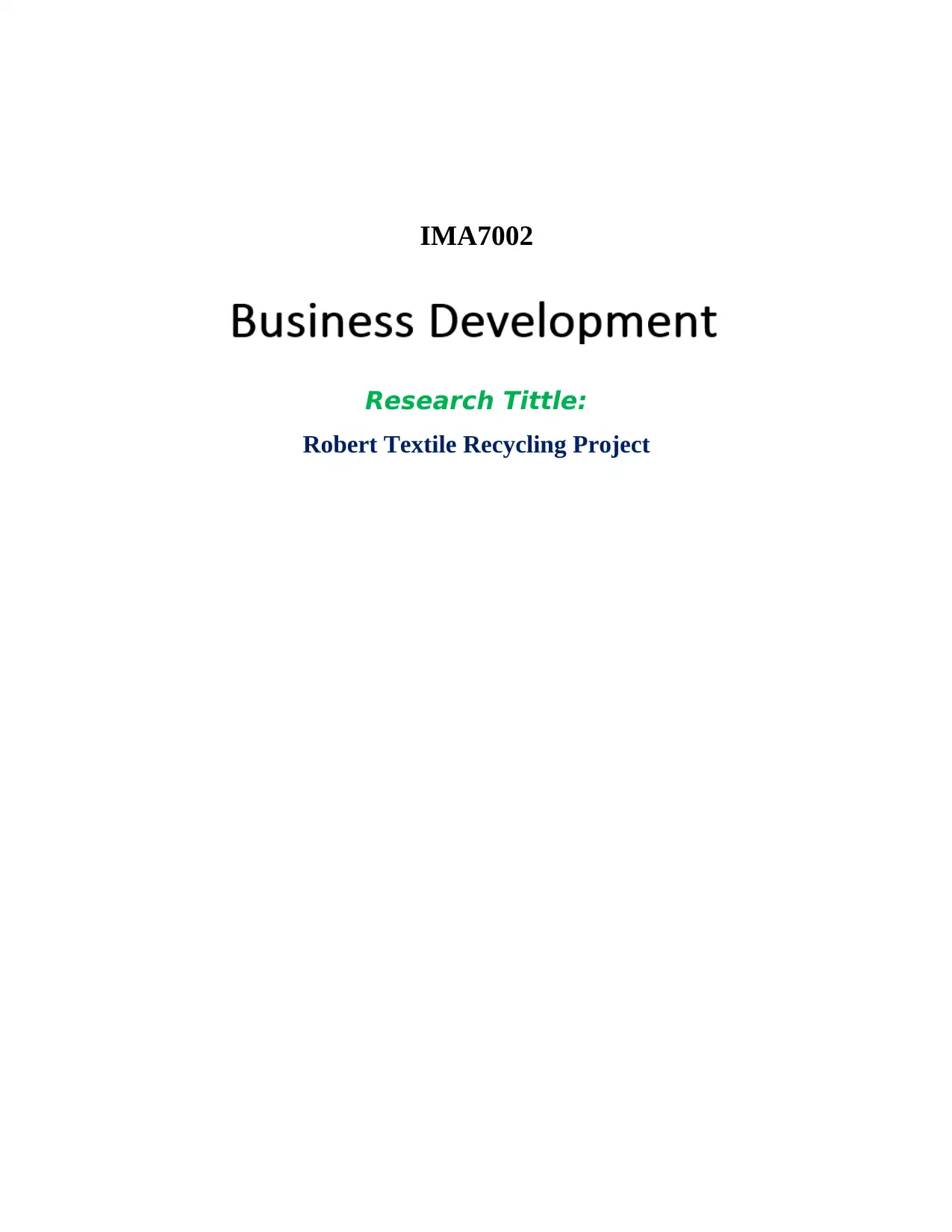
IMA7002
Research Tittle:
Robert Textile Recycling Project
Research Tittle:
Robert Textile Recycling Project
Secure Best Marks with AI Grader
Need help grading? Try our AI Grader for instant feedback on your assignments.
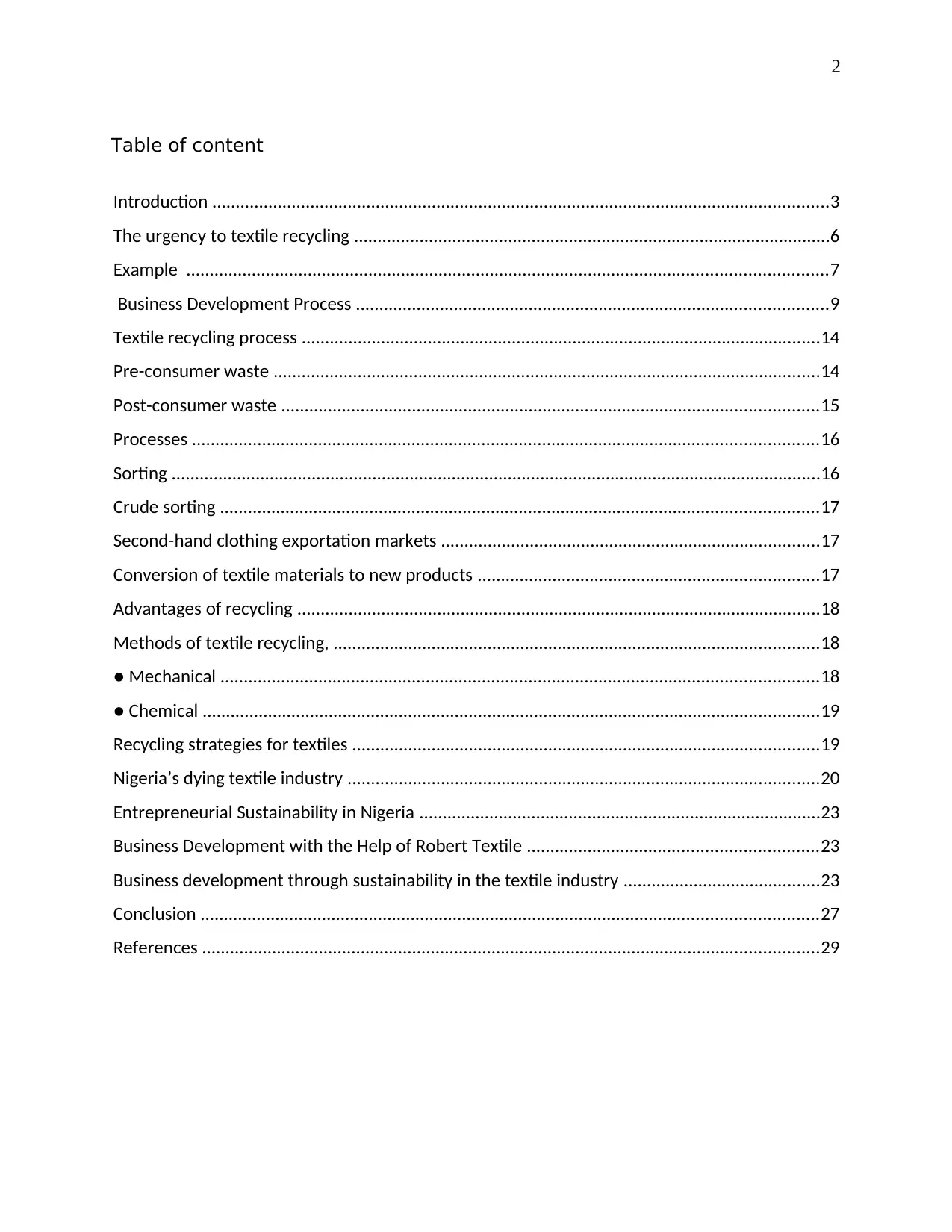
2
Table of content
Introduction ....................................................................................................................................3
The urgency to textile recycling ......................................................................................................6
Example .........................................................................................................................................7
Business Development Process .....................................................................................................9
Textile recycling process ...............................................................................................................14
Pre-consumer waste .....................................................................................................................14
Post-consumer waste ...................................................................................................................15
Processes ......................................................................................................................................16
Sorting ...........................................................................................................................................16
Crude sorting ................................................................................................................................17
Second-hand clothing exportation markets .................................................................................17
Conversion of textile materials to new products .........................................................................17
Advantages of recycling ................................................................................................................18
Methods of textile recycling, ........................................................................................................18
● Mechanical ................................................................................................................................18
● Chemical ....................................................................................................................................19
Recycling strategies for textiles ....................................................................................................19
Nigeria’s dying textile industry .....................................................................................................20
Entrepreneurial Sustainability in Nigeria ......................................................................................23
Business Development with the Help of Robert Textile ..............................................................23
Business development through sustainability in the textile industry ..........................................23
Conclusion ....................................................................................................................................27
References ....................................................................................................................................29
Table of content
Introduction ....................................................................................................................................3
The urgency to textile recycling ......................................................................................................6
Example .........................................................................................................................................7
Business Development Process .....................................................................................................9
Textile recycling process ...............................................................................................................14
Pre-consumer waste .....................................................................................................................14
Post-consumer waste ...................................................................................................................15
Processes ......................................................................................................................................16
Sorting ...........................................................................................................................................16
Crude sorting ................................................................................................................................17
Second-hand clothing exportation markets .................................................................................17
Conversion of textile materials to new products .........................................................................17
Advantages of recycling ................................................................................................................18
Methods of textile recycling, ........................................................................................................18
● Mechanical ................................................................................................................................18
● Chemical ....................................................................................................................................19
Recycling strategies for textiles ....................................................................................................19
Nigeria’s dying textile industry .....................................................................................................20
Entrepreneurial Sustainability in Nigeria ......................................................................................23
Business Development with the Help of Robert Textile ..............................................................23
Business development through sustainability in the textile industry ..........................................23
Conclusion ....................................................................................................................................27
References ....................................................................................................................................29
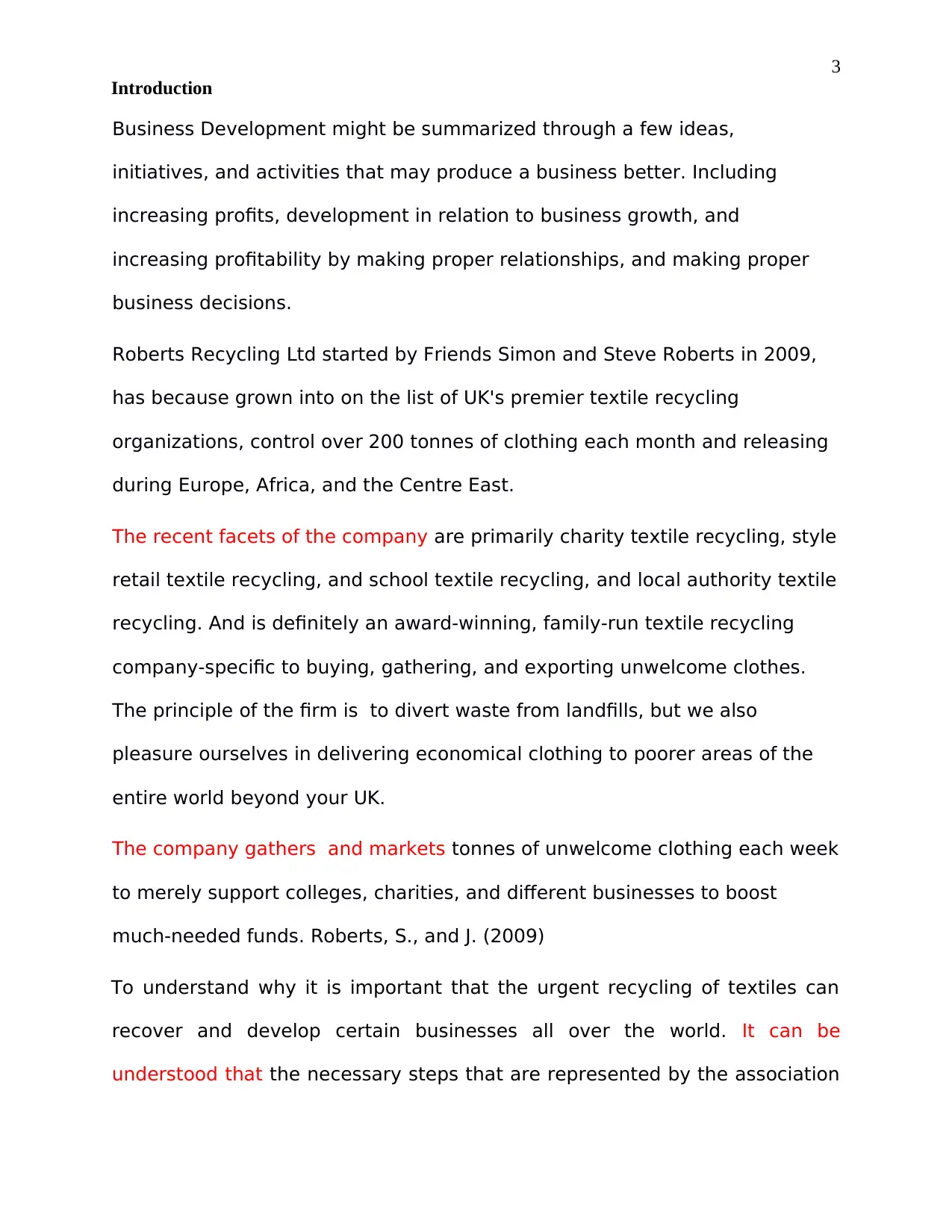
3
Introduction
Business Development might be summarized through a few ideas,
initiatives, and activities that may produce a business better. Including
increasing profits, development in relation to business growth, and
increasing profitability by making proper relationships, and making proper
business decisions.
Roberts Recycling Ltd started by Friends Simon and Steve Roberts in 2009,
has because grown into on the list of UK's premier textile recycling
organizations, control over 200 tonnes of clothing each month and releasing
during Europe, Africa, and the Centre East.
The recent facets of the company are primarily charity textile recycling, style
retail textile recycling, and school textile recycling, and local authority textile
recycling. And is definitely an award-winning, family-run textile recycling
company-specific to buying, gathering, and exporting unwelcome clothes.
The principle of the firm is to divert waste from landfills, but we also
pleasure ourselves in delivering economical clothing to poorer areas of the
entire world beyond your UK.
The company gathers and markets tonnes of unwelcome clothing each week
to merely support colleges, charities, and different businesses to boost
much-needed funds. Roberts, S., and J. (2009)
To understand why it is important that the urgent recycling of textiles can
recover and develop certain businesses all over the world. It can be
understood that the necessary steps that are represented by the association
Introduction
Business Development might be summarized through a few ideas,
initiatives, and activities that may produce a business better. Including
increasing profits, development in relation to business growth, and
increasing profitability by making proper relationships, and making proper
business decisions.
Roberts Recycling Ltd started by Friends Simon and Steve Roberts in 2009,
has because grown into on the list of UK's premier textile recycling
organizations, control over 200 tonnes of clothing each month and releasing
during Europe, Africa, and the Centre East.
The recent facets of the company are primarily charity textile recycling, style
retail textile recycling, and school textile recycling, and local authority textile
recycling. And is definitely an award-winning, family-run textile recycling
company-specific to buying, gathering, and exporting unwelcome clothes.
The principle of the firm is to divert waste from landfills, but we also
pleasure ourselves in delivering economical clothing to poorer areas of the
entire world beyond your UK.
The company gathers and markets tonnes of unwelcome clothing each week
to merely support colleges, charities, and different businesses to boost
much-needed funds. Roberts, S., and J. (2009)
To understand why it is important that the urgent recycling of textiles can
recover and develop certain businesses all over the world. It can be
understood that the necessary steps that are represented by the association
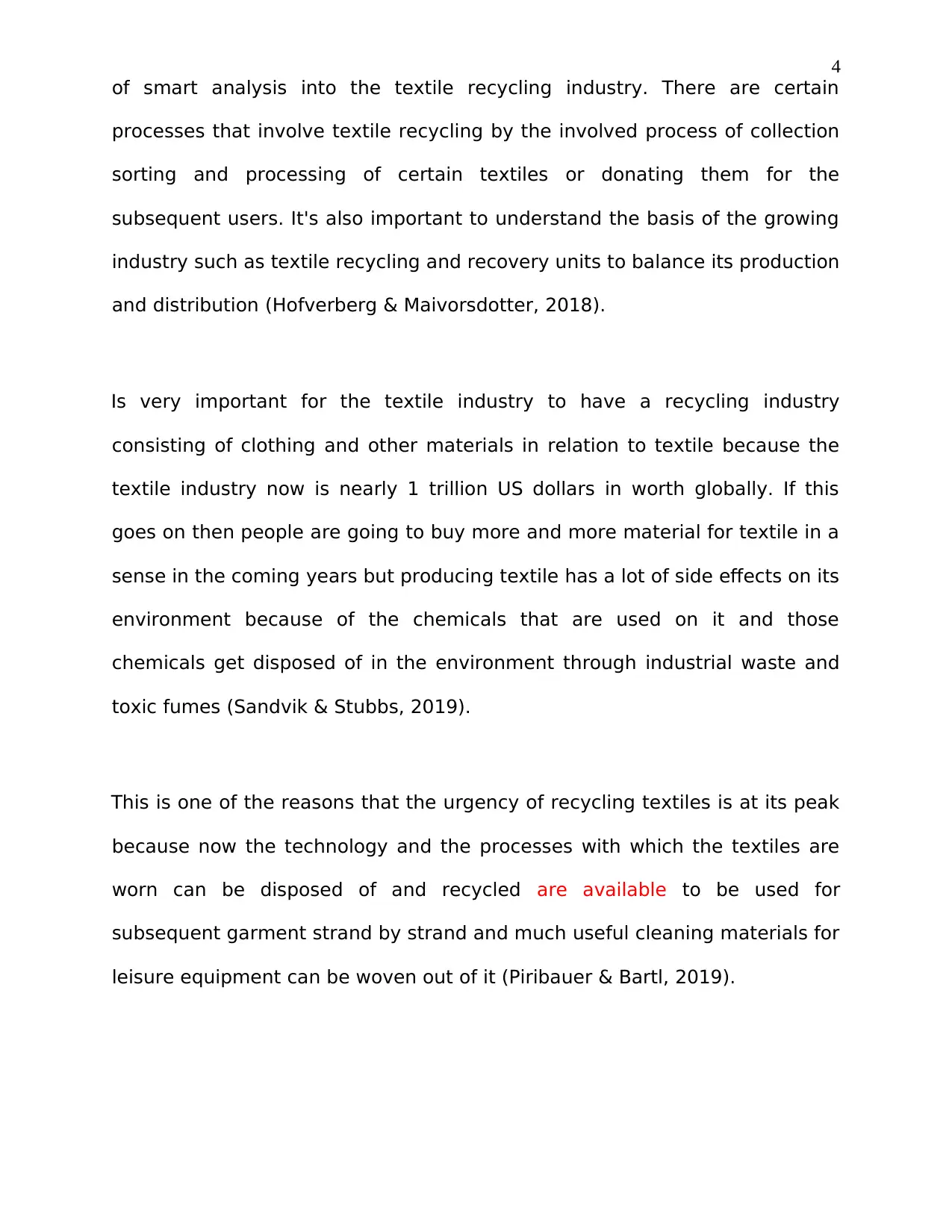
4
of smart analysis into the textile recycling industry. There are certain
processes that involve textile recycling by the involved process of collection
sorting and processing of certain textiles or donating them for the
subsequent users. It's also important to understand the basis of the growing
industry such as textile recycling and recovery units to balance its production
and distribution (Hofverberg & Maivorsdotter, 2018).
Is very important for the textile industry to have a recycling industry
consisting of clothing and other materials in relation to textile because the
textile industry now is nearly 1 trillion US dollars in worth globally. If this
goes on then people are going to buy more and more material for textile in a
sense in the coming years but producing textile has a lot of side effects on its
environment because of the chemicals that are used on it and those
chemicals get disposed of in the environment through industrial waste and
toxic fumes (Sandvik & Stubbs, 2019).
This is one of the reasons that the urgency of recycling textiles is at its peak
because now the technology and the processes with which the textiles are
worn can be disposed of and recycled are available to be used for
subsequent garment strand by strand and much useful cleaning materials for
leisure equipment can be woven out of it (Piribauer & Bartl, 2019).
of smart analysis into the textile recycling industry. There are certain
processes that involve textile recycling by the involved process of collection
sorting and processing of certain textiles or donating them for the
subsequent users. It's also important to understand the basis of the growing
industry such as textile recycling and recovery units to balance its production
and distribution (Hofverberg & Maivorsdotter, 2018).
Is very important for the textile industry to have a recycling industry
consisting of clothing and other materials in relation to textile because the
textile industry now is nearly 1 trillion US dollars in worth globally. If this
goes on then people are going to buy more and more material for textile in a
sense in the coming years but producing textile has a lot of side effects on its
environment because of the chemicals that are used on it and those
chemicals get disposed of in the environment through industrial waste and
toxic fumes (Sandvik & Stubbs, 2019).
This is one of the reasons that the urgency of recycling textiles is at its peak
because now the technology and the processes with which the textiles are
worn can be disposed of and recycled are available to be used for
subsequent garment strand by strand and much useful cleaning materials for
leisure equipment can be woven out of it (Piribauer & Bartl, 2019).
Secure Best Marks with AI Grader
Need help grading? Try our AI Grader for instant feedback on your assignments.
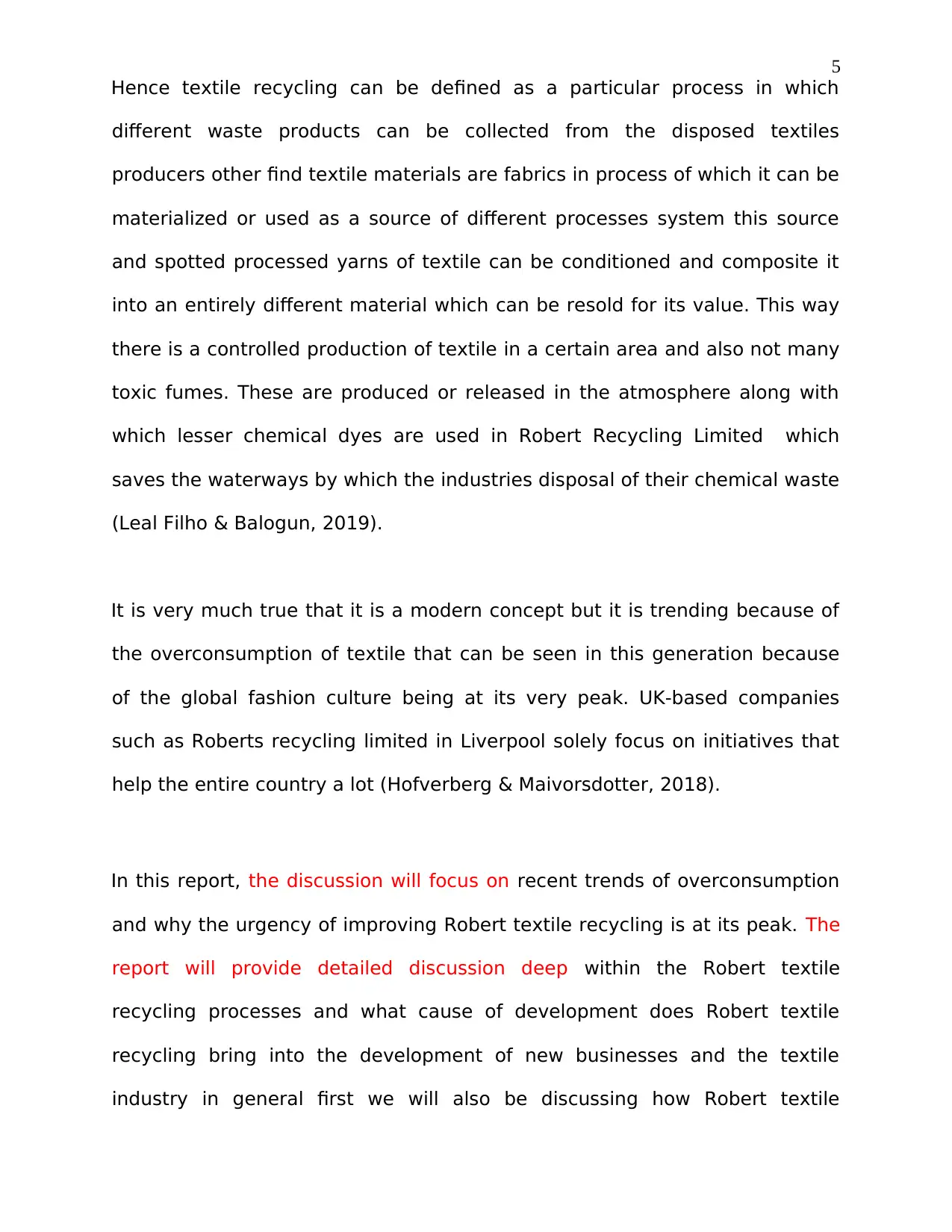
5
Hence textile recycling can be defined as a particular process in which
different waste products can be collected from the disposed textiles
producers other find textile materials are fabrics in process of which it can be
materialized or used as a source of different processes system this source
and spotted processed yarns of textile can be conditioned and composite it
into an entirely different material which can be resold for its value. This way
there is a controlled production of textile in a certain area and also not many
toxic fumes. These are produced or released in the atmosphere along with
which lesser chemical dyes are used in Robert Recycling Limited which
saves the waterways by which the industries disposal of their chemical waste
(Leal Filho & Balogun, 2019).
It is very much true that it is a modern concept but it is trending because of
the overconsumption of textile that can be seen in this generation because
of the global fashion culture being at its very peak. UK-based companies
such as Roberts recycling limited in Liverpool solely focus on initiatives that
help the entire country a lot (Hofverberg & Maivorsdotter, 2018).
In this report, the discussion will focus on recent trends of overconsumption
and why the urgency of improving Robert textile recycling is at its peak. The
report will provide detailed discussion deep within the Robert textile
recycling processes and what cause of development does Robert textile
recycling bring into the development of new businesses and the textile
industry in general first we will also be discussing how Robert textile
Hence textile recycling can be defined as a particular process in which
different waste products can be collected from the disposed textiles
producers other find textile materials are fabrics in process of which it can be
materialized or used as a source of different processes system this source
and spotted processed yarns of textile can be conditioned and composite it
into an entirely different material which can be resold for its value. This way
there is a controlled production of textile in a certain area and also not many
toxic fumes. These are produced or released in the atmosphere along with
which lesser chemical dyes are used in Robert Recycling Limited which
saves the waterways by which the industries disposal of their chemical waste
(Leal Filho & Balogun, 2019).
It is very much true that it is a modern concept but it is trending because of
the overconsumption of textile that can be seen in this generation because
of the global fashion culture being at its very peak. UK-based companies
such as Roberts recycling limited in Liverpool solely focus on initiatives that
help the entire country a lot (Hofverberg & Maivorsdotter, 2018).
In this report, the discussion will focus on recent trends of overconsumption
and why the urgency of improving Robert textile recycling is at its peak. The
report will provide detailed discussion deep within the Robert textile
recycling processes and what cause of development does Robert textile
recycling bring into the development of new businesses and the textile
industry in general first we will also be discussing how Robert textile
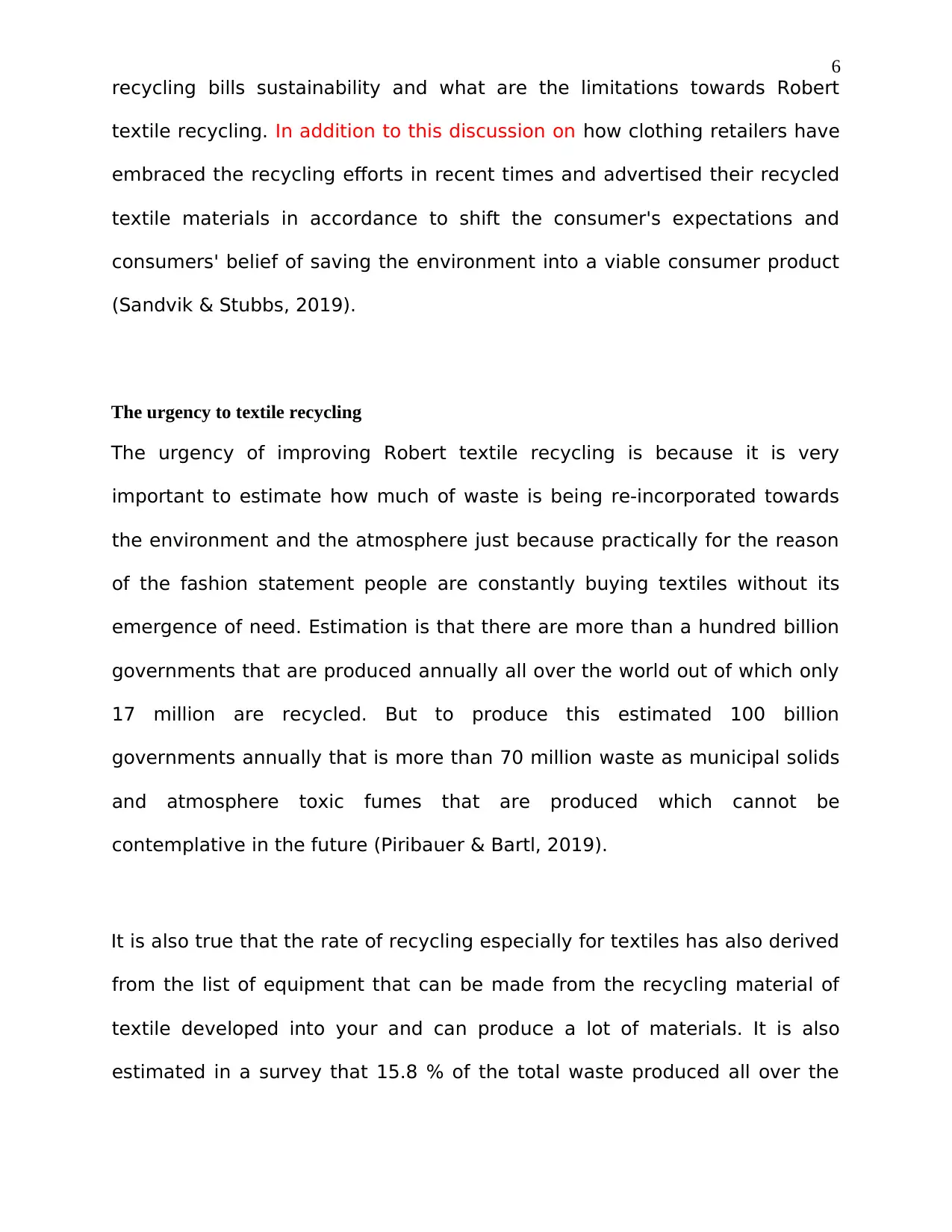
6
recycling bills sustainability and what are the limitations towards Robert
textile recycling. In addition to this discussion on how clothing retailers have
embraced the recycling efforts in recent times and advertised their recycled
textile materials in accordance to shift the consumer's expectations and
consumers' belief of saving the environment into a viable consumer product
(Sandvik & Stubbs, 2019).
The urgency to textile recycling
The urgency of improving Robert textile recycling is because it is very
important to estimate how much of waste is being re-incorporated towards
the environment and the atmosphere just because practically for the reason
of the fashion statement people are constantly buying textiles without its
emergence of need. Estimation is that there are more than a hundred billion
governments that are produced annually all over the world out of which only
17 million are recycled. But to produce this estimated 100 billion
governments annually that is more than 70 million waste as municipal solids
and atmosphere toxic fumes that are produced which cannot be
contemplative in the future (Piribauer & Bartl, 2019).
It is also true that the rate of recycling especially for textiles has also derived
from the list of equipment that can be made from the recycling material of
textile developed into your and can produce a lot of materials. It is also
estimated in a survey that 15.8 % of the total waste produced all over the
recycling bills sustainability and what are the limitations towards Robert
textile recycling. In addition to this discussion on how clothing retailers have
embraced the recycling efforts in recent times and advertised their recycled
textile materials in accordance to shift the consumer's expectations and
consumers' belief of saving the environment into a viable consumer product
(Sandvik & Stubbs, 2019).
The urgency to textile recycling
The urgency of improving Robert textile recycling is because it is very
important to estimate how much of waste is being re-incorporated towards
the environment and the atmosphere just because practically for the reason
of the fashion statement people are constantly buying textiles without its
emergence of need. Estimation is that there are more than a hundred billion
governments that are produced annually all over the world out of which only
17 million are recycled. But to produce this estimated 100 billion
governments annually that is more than 70 million waste as municipal solids
and atmosphere toxic fumes that are produced which cannot be
contemplative in the future (Piribauer & Bartl, 2019).
It is also true that the rate of recycling especially for textiles has also derived
from the list of equipment that can be made from the recycling material of
textile developed into your and can produce a lot of materials. It is also
estimated in a survey that 15.8 % of the total waste produced all over the
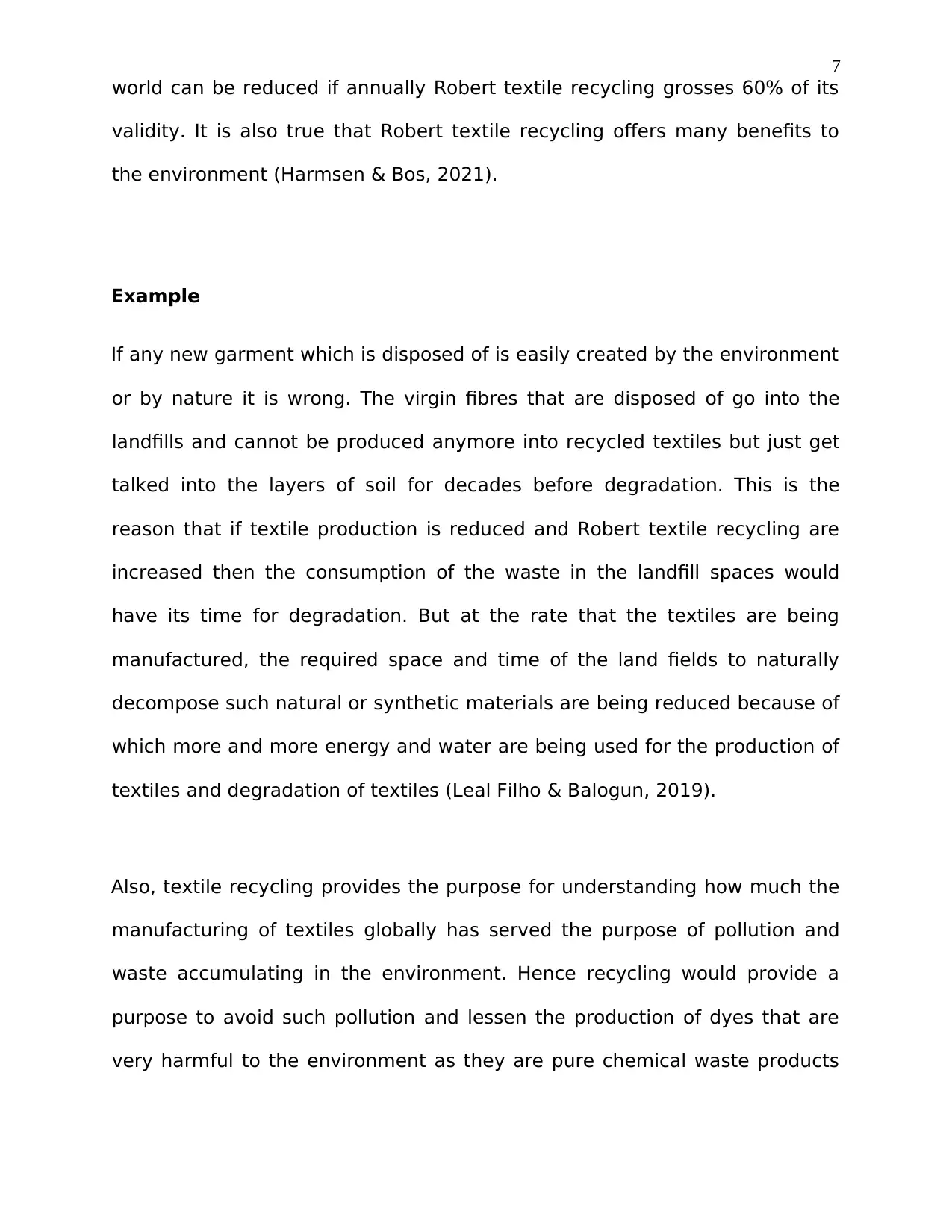
7
world can be reduced if annually Robert textile recycling grosses 60% of its
validity. It is also true that Robert textile recycling offers many benefits to
the environment (Harmsen & Bos, 2021).
Example
If any new garment which is disposed of is easily created by the environment
or by nature it is wrong. The virgin fibres that are disposed of go into the
landfills and cannot be produced anymore into recycled textiles but just get
talked into the layers of soil for decades before degradation. This is the
reason that if textile production is reduced and Robert textile recycling are
increased then the consumption of the waste in the landfill spaces would
have its time for degradation. But at the rate that the textiles are being
manufactured, the required space and time of the land fields to naturally
decompose such natural or synthetic materials are being reduced because of
which more and more energy and water are being used for the production of
textiles and degradation of textiles (Leal Filho & Balogun, 2019).
Also, textile recycling provides the purpose for understanding how much the
manufacturing of textiles globally has served the purpose of pollution and
waste accumulating in the environment. Hence recycling would provide a
purpose to avoid such pollution and lessen the production of dyes that are
very harmful to the environment as they are pure chemical waste products
world can be reduced if annually Robert textile recycling grosses 60% of its
validity. It is also true that Robert textile recycling offers many benefits to
the environment (Harmsen & Bos, 2021).
Example
If any new garment which is disposed of is easily created by the environment
or by nature it is wrong. The virgin fibres that are disposed of go into the
landfills and cannot be produced anymore into recycled textiles but just get
talked into the layers of soil for decades before degradation. This is the
reason that if textile production is reduced and Robert textile recycling are
increased then the consumption of the waste in the landfill spaces would
have its time for degradation. But at the rate that the textiles are being
manufactured, the required space and time of the land fields to naturally
decompose such natural or synthetic materials are being reduced because of
which more and more energy and water are being used for the production of
textiles and degradation of textiles (Leal Filho & Balogun, 2019).
Also, textile recycling provides the purpose for understanding how much the
manufacturing of textiles globally has served the purpose of pollution and
waste accumulating in the environment. Hence recycling would provide a
purpose to avoid such pollution and lessen the production of dyes that are
very harmful to the environment as they are pure chemical waste products
Paraphrase This Document
Need a fresh take? Get an instant paraphrase of this document with our AI Paraphraser
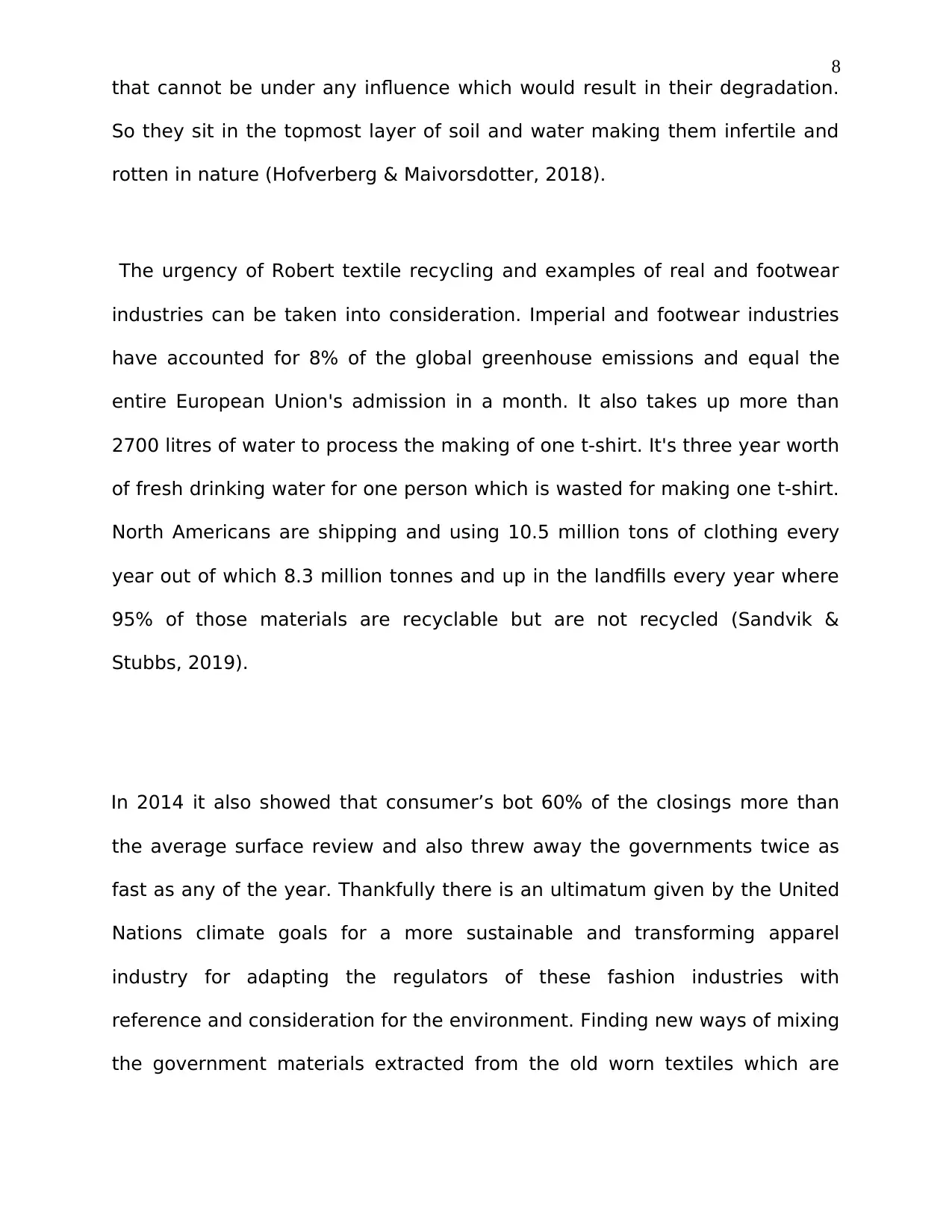
8
that cannot be under any influence which would result in their degradation.
So they sit in the topmost layer of soil and water making them infertile and
rotten in nature (Hofverberg & Maivorsdotter, 2018).
The urgency of Robert textile recycling and examples of real and footwear
industries can be taken into consideration. Imperial and footwear industries
have accounted for 8% of the global greenhouse emissions and equal the
entire European Union's admission in a month. It also takes up more than
2700 litres of water to process the making of one t-shirt. It's three year worth
of fresh drinking water for one person which is wasted for making one t-shirt.
North Americans are shipping and using 10.5 million tons of clothing every
year out of which 8.3 million tonnes and up in the landfills every year where
95% of those materials are recyclable but are not recycled (Sandvik &
Stubbs, 2019).
In 2014 it also showed that consumer’s bot 60% of the closings more than
the average surface review and also threw away the governments twice as
fast as any of the year. Thankfully there is an ultimatum given by the United
Nations climate goals for a more sustainable and transforming apparel
industry for adapting the regulators of these fashion industries with
reference and consideration for the environment. Finding new ways of mixing
the government materials extracted from the old worn textiles which are
that cannot be under any influence which would result in their degradation.
So they sit in the topmost layer of soil and water making them infertile and
rotten in nature (Hofverberg & Maivorsdotter, 2018).
The urgency of Robert textile recycling and examples of real and footwear
industries can be taken into consideration. Imperial and footwear industries
have accounted for 8% of the global greenhouse emissions and equal the
entire European Union's admission in a month. It also takes up more than
2700 litres of water to process the making of one t-shirt. It's three year worth
of fresh drinking water for one person which is wasted for making one t-shirt.
North Americans are shipping and using 10.5 million tons of clothing every
year out of which 8.3 million tonnes and up in the landfills every year where
95% of those materials are recyclable but are not recycled (Sandvik &
Stubbs, 2019).
In 2014 it also showed that consumer’s bot 60% of the closings more than
the average surface review and also threw away the governments twice as
fast as any of the year. Thankfully there is an ultimatum given by the United
Nations climate goals for a more sustainable and transforming apparel
industry for adapting the regulators of these fashion industries with
reference and consideration for the environment. Finding new ways of mixing
the government materials extracted from the old worn textiles which are
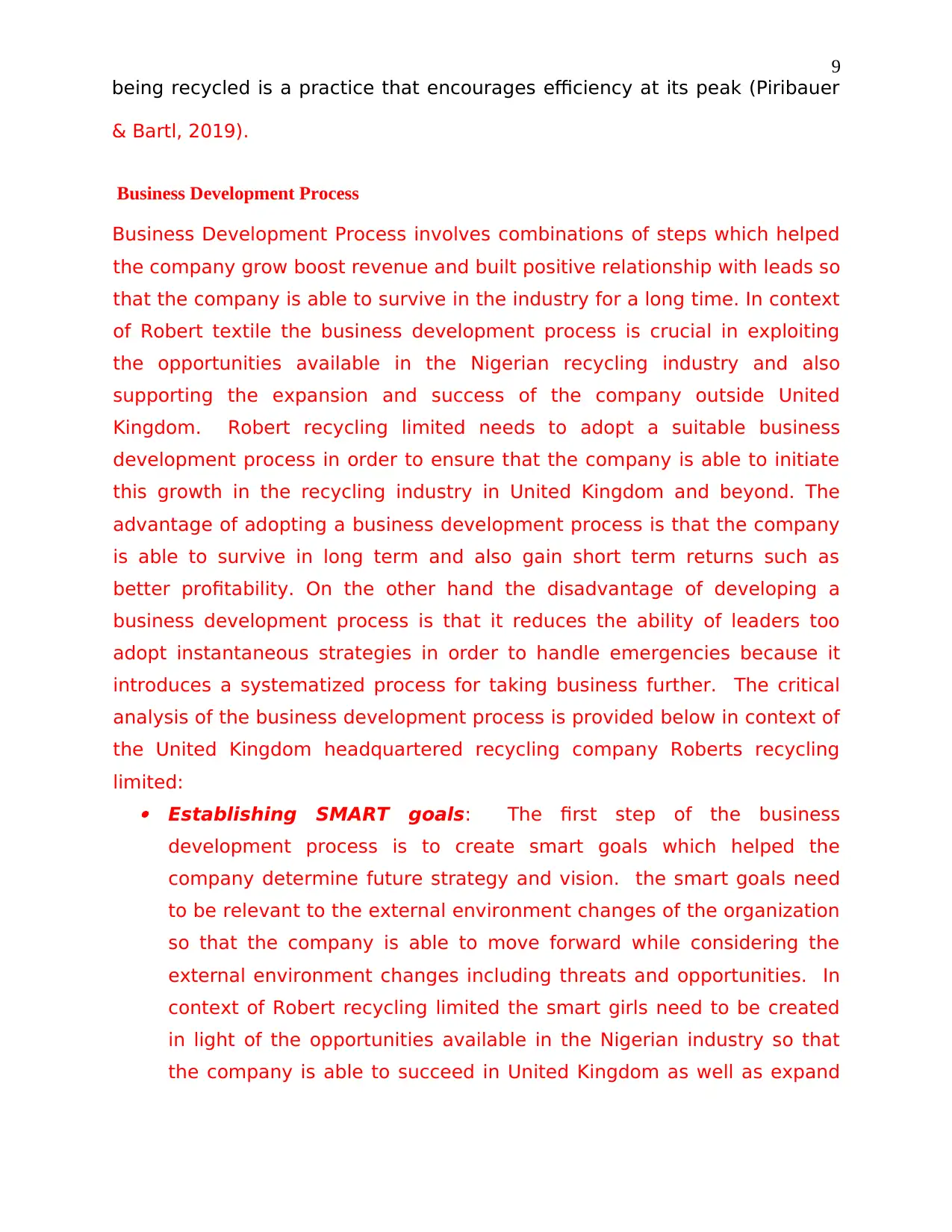
9
being recycled is a practice that encourages efficiency at its peak (Piribauer
& Bartl, 2019).
Business Development Process
Business Development Process involves combinations of steps which helped
the company grow boost revenue and built positive relationship with leads so
that the company is able to survive in the industry for a long time. In context
of Robert textile the business development process is crucial in exploiting
the opportunities available in the Nigerian recycling industry and also
supporting the expansion and success of the company outside United
Kingdom. Robert recycling limited needs to adopt a suitable business
development process in order to ensure that the company is able to initiate
this growth in the recycling industry in United Kingdom and beyond. The
advantage of adopting a business development process is that the company
is able to survive in long term and also gain short term returns such as
better profitability. On the other hand the disadvantage of developing a
business development process is that it reduces the ability of leaders too
adopt instantaneous strategies in order to handle emergencies because it
introduces a systematized process for taking business further. The critical
analysis of the business development process is provided below in context of
the United Kingdom headquartered recycling company Roberts recycling
limited: Establishing SMART goals: The first step of the business
development process is to create smart goals which helped the
company determine future strategy and vision. the smart goals need
to be relevant to the external environment changes of the organization
so that the company is able to move forward while considering the
external environment changes including threats and opportunities. In
context of Robert recycling limited the smart girls need to be created
in light of the opportunities available in the Nigerian industry so that
the company is able to succeed in United Kingdom as well as expand
being recycled is a practice that encourages efficiency at its peak (Piribauer
& Bartl, 2019).
Business Development Process
Business Development Process involves combinations of steps which helped
the company grow boost revenue and built positive relationship with leads so
that the company is able to survive in the industry for a long time. In context
of Robert textile the business development process is crucial in exploiting
the opportunities available in the Nigerian recycling industry and also
supporting the expansion and success of the company outside United
Kingdom. Robert recycling limited needs to adopt a suitable business
development process in order to ensure that the company is able to initiate
this growth in the recycling industry in United Kingdom and beyond. The
advantage of adopting a business development process is that the company
is able to survive in long term and also gain short term returns such as
better profitability. On the other hand the disadvantage of developing a
business development process is that it reduces the ability of leaders too
adopt instantaneous strategies in order to handle emergencies because it
introduces a systematized process for taking business further. The critical
analysis of the business development process is provided below in context of
the United Kingdom headquartered recycling company Roberts recycling
limited: Establishing SMART goals: The first step of the business
development process is to create smart goals which helped the
company determine future strategy and vision. the smart goals need
to be relevant to the external environment changes of the organization
so that the company is able to move forward while considering the
external environment changes including threats and opportunities. In
context of Robert recycling limited the smart girls need to be created
in light of the opportunities available in the Nigerian industry so that
the company is able to succeed in United Kingdom as well as expand
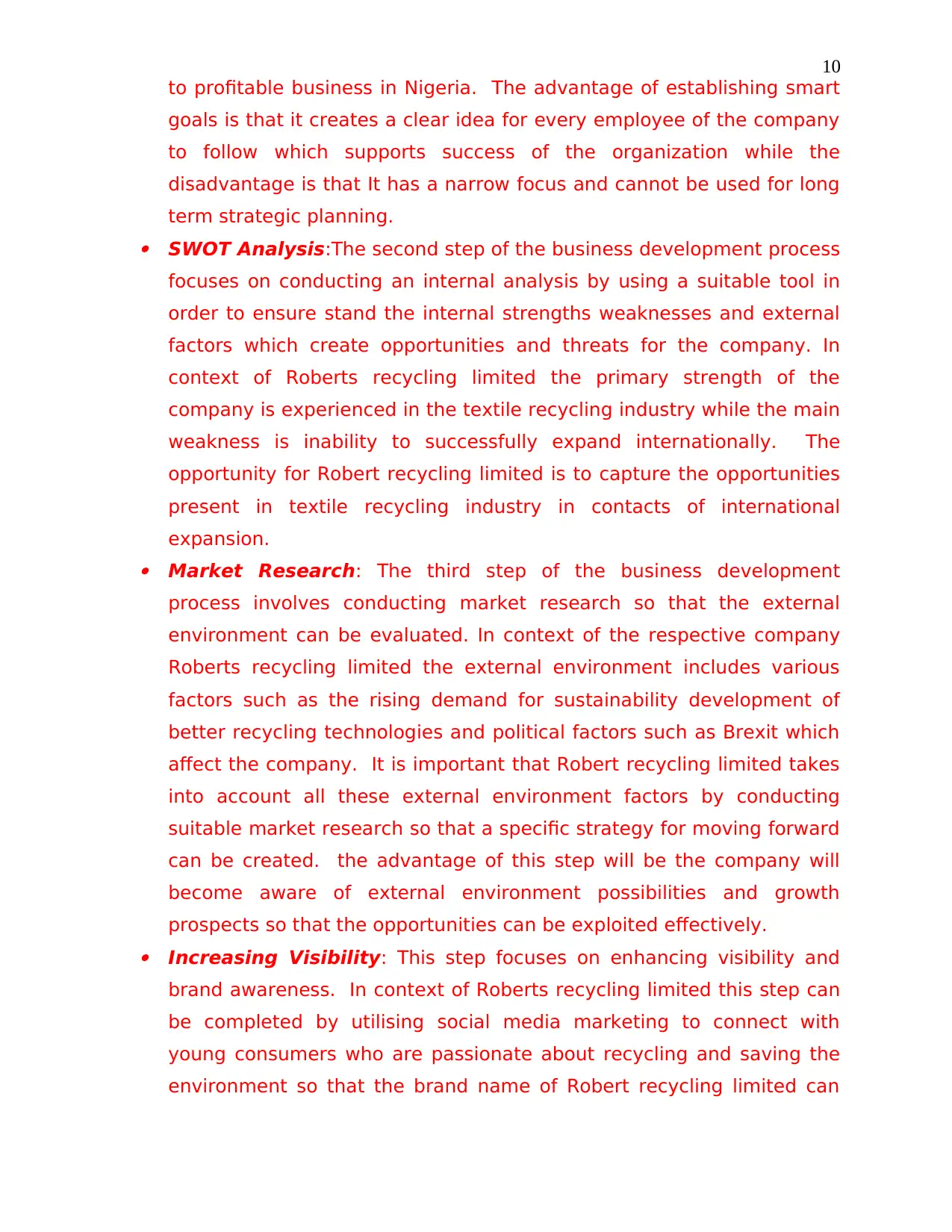
10
to profitable business in Nigeria. The advantage of establishing smart
goals is that it creates a clear idea for every employee of the company
to follow which supports success of the organization while the
disadvantage is that It has a narrow focus and cannot be used for long
term strategic planning. SWOT Analysis:The second step of the business development process
focuses on conducting an internal analysis by using a suitable tool in
order to ensure stand the internal strengths weaknesses and external
factors which create opportunities and threats for the company. In
context of Roberts recycling limited the primary strength of the
company is experienced in the textile recycling industry while the main
weakness is inability to successfully expand internationally. The
opportunity for Robert recycling limited is to capture the opportunities
present in textile recycling industry in contacts of international
expansion. Market Research: The third step of the business development
process involves conducting market research so that the external
environment can be evaluated. In context of the respective company
Roberts recycling limited the external environment includes various
factors such as the rising demand for sustainability development of
better recycling technologies and political factors such as Brexit which
affect the company. It is important that Robert recycling limited takes
into account all these external environment factors by conducting
suitable market research so that a specific strategy for moving forward
can be created. the advantage of this step will be the company will
become aware of external environment possibilities and growth
prospects so that the opportunities can be exploited effectively. Increasing Visibility: This step focuses on enhancing visibility and
brand awareness. In context of Roberts recycling limited this step can
be completed by utilising social media marketing to connect with
young consumers who are passionate about recycling and saving the
environment so that the brand name of Robert recycling limited can
to profitable business in Nigeria. The advantage of establishing smart
goals is that it creates a clear idea for every employee of the company
to follow which supports success of the organization while the
disadvantage is that It has a narrow focus and cannot be used for long
term strategic planning. SWOT Analysis:The second step of the business development process
focuses on conducting an internal analysis by using a suitable tool in
order to ensure stand the internal strengths weaknesses and external
factors which create opportunities and threats for the company. In
context of Roberts recycling limited the primary strength of the
company is experienced in the textile recycling industry while the main
weakness is inability to successfully expand internationally. The
opportunity for Robert recycling limited is to capture the opportunities
present in textile recycling industry in contacts of international
expansion. Market Research: The third step of the business development
process involves conducting market research so that the external
environment can be evaluated. In context of the respective company
Roberts recycling limited the external environment includes various
factors such as the rising demand for sustainability development of
better recycling technologies and political factors such as Brexit which
affect the company. It is important that Robert recycling limited takes
into account all these external environment factors by conducting
suitable market research so that a specific strategy for moving forward
can be created. the advantage of this step will be the company will
become aware of external environment possibilities and growth
prospects so that the opportunities can be exploited effectively. Increasing Visibility: This step focuses on enhancing visibility and
brand awareness. In context of Roberts recycling limited this step can
be completed by utilising social media marketing to connect with
young consumers who are passionate about recycling and saving the
environment so that the brand name of Robert recycling limited can
Secure Best Marks with AI Grader
Need help grading? Try our AI Grader for instant feedback on your assignments.
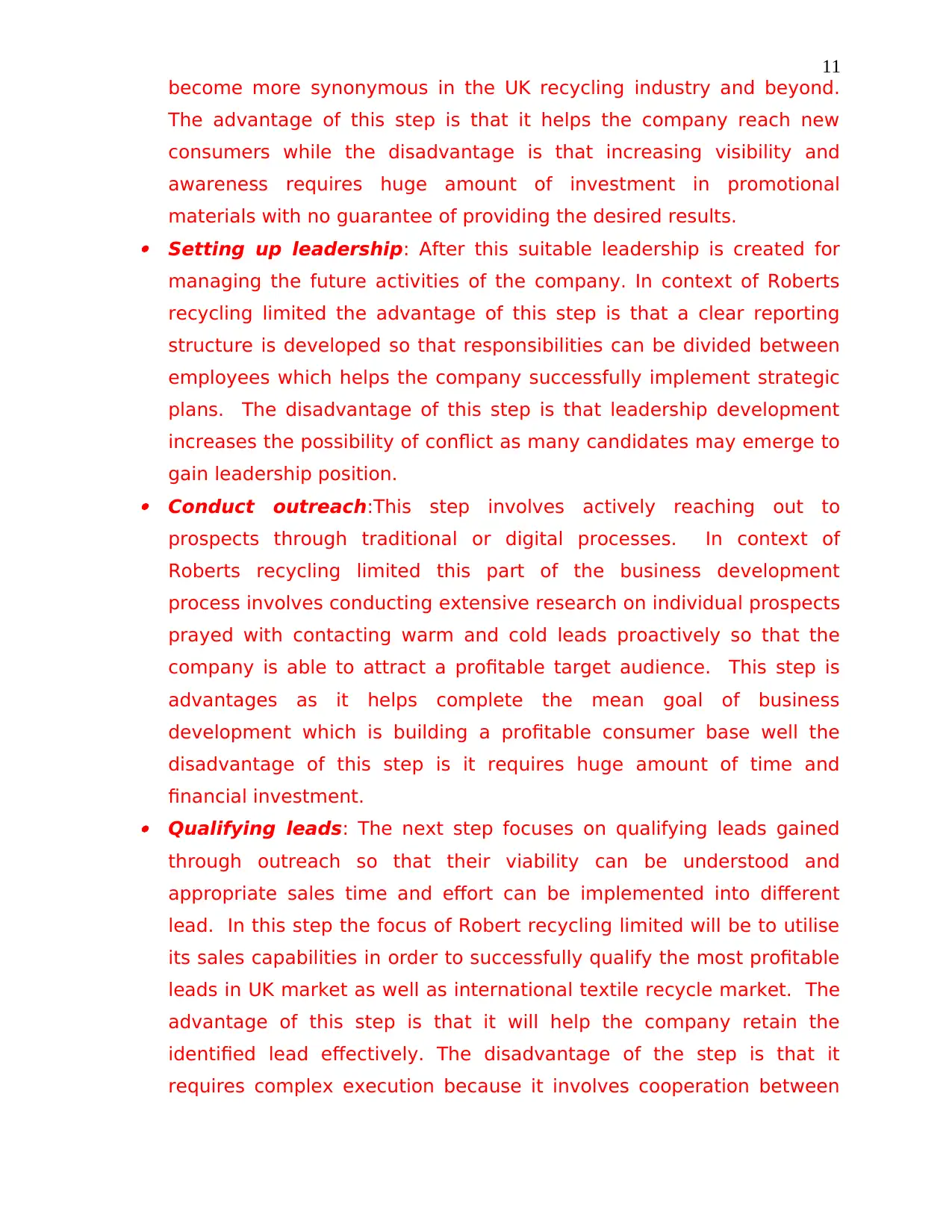
11
become more synonymous in the UK recycling industry and beyond.
The advantage of this step is that it helps the company reach new
consumers while the disadvantage is that increasing visibility and
awareness requires huge amount of investment in promotional
materials with no guarantee of providing the desired results. Setting up leadership: After this suitable leadership is created for
managing the future activities of the company. In context of Roberts
recycling limited the advantage of this step is that a clear reporting
structure is developed so that responsibilities can be divided between
employees which helps the company successfully implement strategic
plans. The disadvantage of this step is that leadership development
increases the possibility of conflict as many candidates may emerge to
gain leadership position. Conduct outreach:This step involves actively reaching out to
prospects through traditional or digital processes. In context of
Roberts recycling limited this part of the business development
process involves conducting extensive research on individual prospects
prayed with contacting warm and cold leads proactively so that the
company is able to attract a profitable target audience. This step is
advantages as it helps complete the mean goal of business
development which is building a profitable consumer base well the
disadvantage of this step is it requires huge amount of time and
financial investment. Qualifying leads: The next step focuses on qualifying leads gained
through outreach so that their viability can be understood and
appropriate sales time and effort can be implemented into different
lead. In this step the focus of Robert recycling limited will be to utilise
its sales capabilities in order to successfully qualify the most profitable
leads in UK market as well as international textile recycle market. The
advantage of this step is that it will help the company retain the
identified lead effectively. The disadvantage of the step is that it
requires complex execution because it involves cooperation between
become more synonymous in the UK recycling industry and beyond.
The advantage of this step is that it helps the company reach new
consumers while the disadvantage is that increasing visibility and
awareness requires huge amount of investment in promotional
materials with no guarantee of providing the desired results. Setting up leadership: After this suitable leadership is created for
managing the future activities of the company. In context of Roberts
recycling limited the advantage of this step is that a clear reporting
structure is developed so that responsibilities can be divided between
employees which helps the company successfully implement strategic
plans. The disadvantage of this step is that leadership development
increases the possibility of conflict as many candidates may emerge to
gain leadership position. Conduct outreach:This step involves actively reaching out to
prospects through traditional or digital processes. In context of
Roberts recycling limited this part of the business development
process involves conducting extensive research on individual prospects
prayed with contacting warm and cold leads proactively so that the
company is able to attract a profitable target audience. This step is
advantages as it helps complete the mean goal of business
development which is building a profitable consumer base well the
disadvantage of this step is it requires huge amount of time and
financial investment. Qualifying leads: The next step focuses on qualifying leads gained
through outreach so that their viability can be understood and
appropriate sales time and effort can be implemented into different
lead. In this step the focus of Robert recycling limited will be to utilise
its sales capabilities in order to successfully qualify the most profitable
leads in UK market as well as international textile recycle market. The
advantage of this step is that it will help the company retain the
identified lead effectively. The disadvantage of the step is that it
requires complex execution because it involves cooperation between
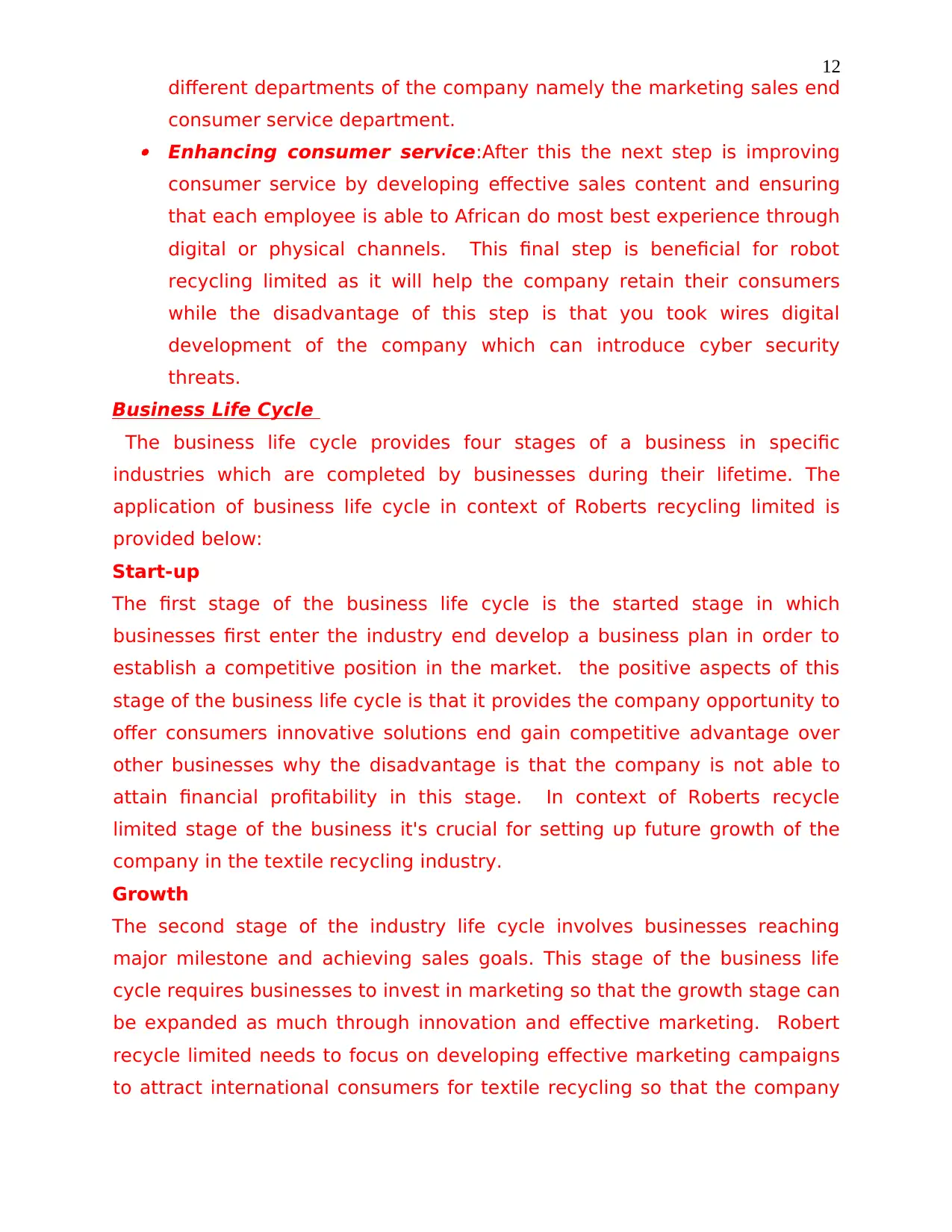
12
different departments of the company namely the marketing sales end
consumer service department. Enhancing consumer service:After this the next step is improving
consumer service by developing effective sales content and ensuring
that each employee is able to African do most best experience through
digital or physical channels. This final step is beneficial for robot
recycling limited as it will help the company retain their consumers
while the disadvantage of this step is that you took wires digital
development of the company which can introduce cyber security
threats.
Business Life Cycle
The business life cycle provides four stages of a business in specific
industries which are completed by businesses during their lifetime. The
application of business life cycle in context of Roberts recycling limited is
provided below:
Start-up
The first stage of the business life cycle is the started stage in which
businesses first enter the industry end develop a business plan in order to
establish a competitive position in the market. the positive aspects of this
stage of the business life cycle is that it provides the company opportunity to
offer consumers innovative solutions end gain competitive advantage over
other businesses why the disadvantage is that the company is not able to
attain financial profitability in this stage. In context of Roberts recycle
limited stage of the business it's crucial for setting up future growth of the
company in the textile recycling industry.
Growth
The second stage of the industry life cycle involves businesses reaching
major milestone and achieving sales goals. This stage of the business life
cycle requires businesses to invest in marketing so that the growth stage can
be expanded as much through innovation and effective marketing. Robert
recycle limited needs to focus on developing effective marketing campaigns
to attract international consumers for textile recycling so that the company
different departments of the company namely the marketing sales end
consumer service department. Enhancing consumer service:After this the next step is improving
consumer service by developing effective sales content and ensuring
that each employee is able to African do most best experience through
digital or physical channels. This final step is beneficial for robot
recycling limited as it will help the company retain their consumers
while the disadvantage of this step is that you took wires digital
development of the company which can introduce cyber security
threats.
Business Life Cycle
The business life cycle provides four stages of a business in specific
industries which are completed by businesses during their lifetime. The
application of business life cycle in context of Roberts recycling limited is
provided below:
Start-up
The first stage of the business life cycle is the started stage in which
businesses first enter the industry end develop a business plan in order to
establish a competitive position in the market. the positive aspects of this
stage of the business life cycle is that it provides the company opportunity to
offer consumers innovative solutions end gain competitive advantage over
other businesses why the disadvantage is that the company is not able to
attain financial profitability in this stage. In context of Roberts recycle
limited stage of the business it's crucial for setting up future growth of the
company in the textile recycling industry.
Growth
The second stage of the industry life cycle involves businesses reaching
major milestone and achieving sales goals. This stage of the business life
cycle requires businesses to invest in marketing so that the growth stage can
be expanded as much through innovation and effective marketing. Robert
recycle limited needs to focus on developing effective marketing campaigns
to attract international consumers for textile recycling so that the company
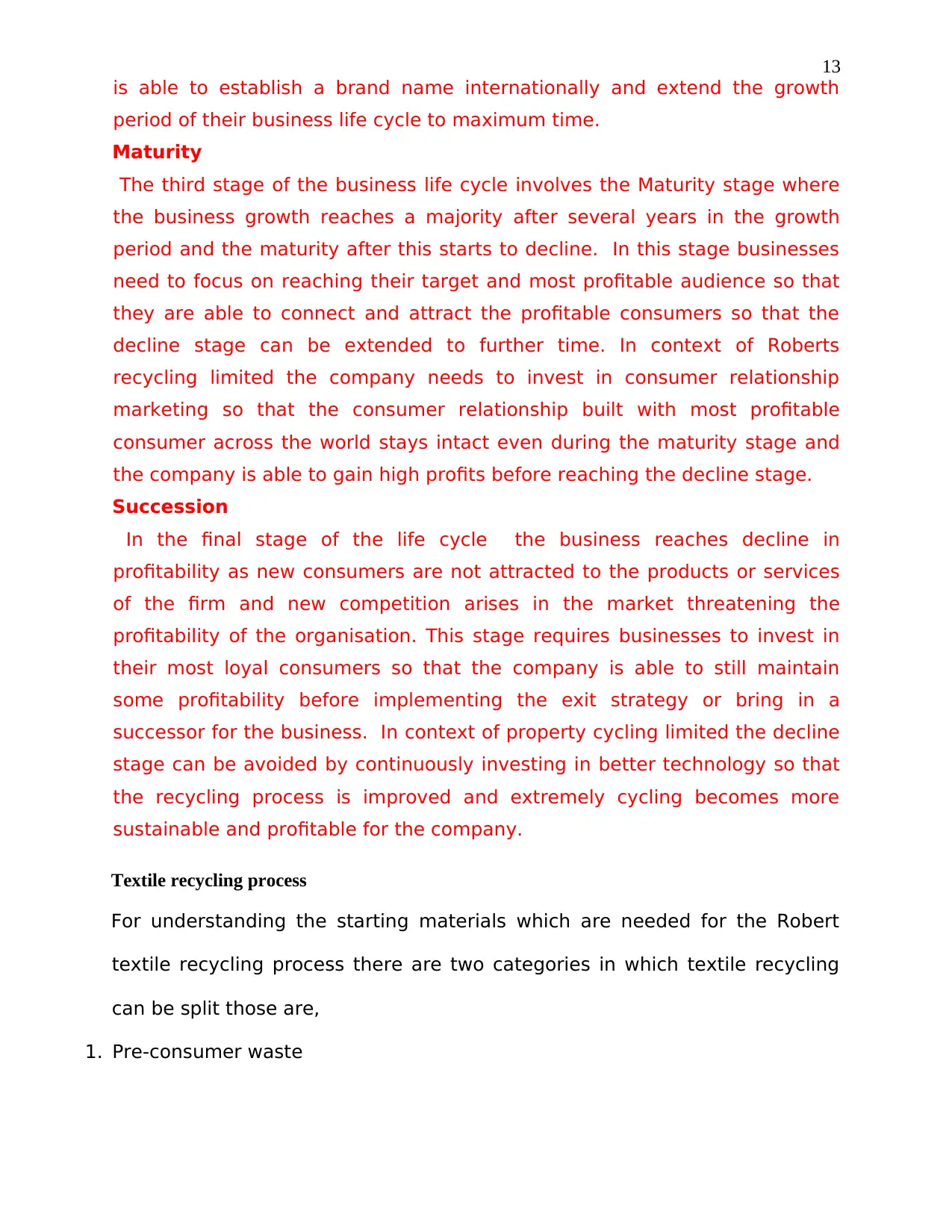
13
is able to establish a brand name internationally and extend the growth
period of their business life cycle to maximum time.
Maturity
The third stage of the business life cycle involves the Maturity stage where
the business growth reaches a majority after several years in the growth
period and the maturity after this starts to decline. In this stage businesses
need to focus on reaching their target and most profitable audience so that
they are able to connect and attract the profitable consumers so that the
decline stage can be extended to further time. In context of Roberts
recycling limited the company needs to invest in consumer relationship
marketing so that the consumer relationship built with most profitable
consumer across the world stays intact even during the maturity stage and
the company is able to gain high profits before reaching the decline stage.
Succession
In the final stage of the life cycle the business reaches decline in
profitability as new consumers are not attracted to the products or services
of the firm and new competition arises in the market threatening the
profitability of the organisation. This stage requires businesses to invest in
their most loyal consumers so that the company is able to still maintain
some profitability before implementing the exit strategy or bring in a
successor for the business. In context of property cycling limited the decline
stage can be avoided by continuously investing in better technology so that
the recycling process is improved and extremely cycling becomes more
sustainable and profitable for the company.
Textile recycling process
For understanding the starting materials which are needed for the Robert
textile recycling process there are two categories in which textile recycling
can be split those are,
1. Pre-consumer waste
is able to establish a brand name internationally and extend the growth
period of their business life cycle to maximum time.
Maturity
The third stage of the business life cycle involves the Maturity stage where
the business growth reaches a majority after several years in the growth
period and the maturity after this starts to decline. In this stage businesses
need to focus on reaching their target and most profitable audience so that
they are able to connect and attract the profitable consumers so that the
decline stage can be extended to further time. In context of Roberts
recycling limited the company needs to invest in consumer relationship
marketing so that the consumer relationship built with most profitable
consumer across the world stays intact even during the maturity stage and
the company is able to gain high profits before reaching the decline stage.
Succession
In the final stage of the life cycle the business reaches decline in
profitability as new consumers are not attracted to the products or services
of the firm and new competition arises in the market threatening the
profitability of the organisation. This stage requires businesses to invest in
their most loyal consumers so that the company is able to still maintain
some profitability before implementing the exit strategy or bring in a
successor for the business. In context of property cycling limited the decline
stage can be avoided by continuously investing in better technology so that
the recycling process is improved and extremely cycling becomes more
sustainable and profitable for the company.
Textile recycling process
For understanding the starting materials which are needed for the Robert
textile recycling process there are two categories in which textile recycling
can be split those are,
1. Pre-consumer waste
Paraphrase This Document
Need a fresh take? Get an instant paraphrase of this document with our AI Paraphraser
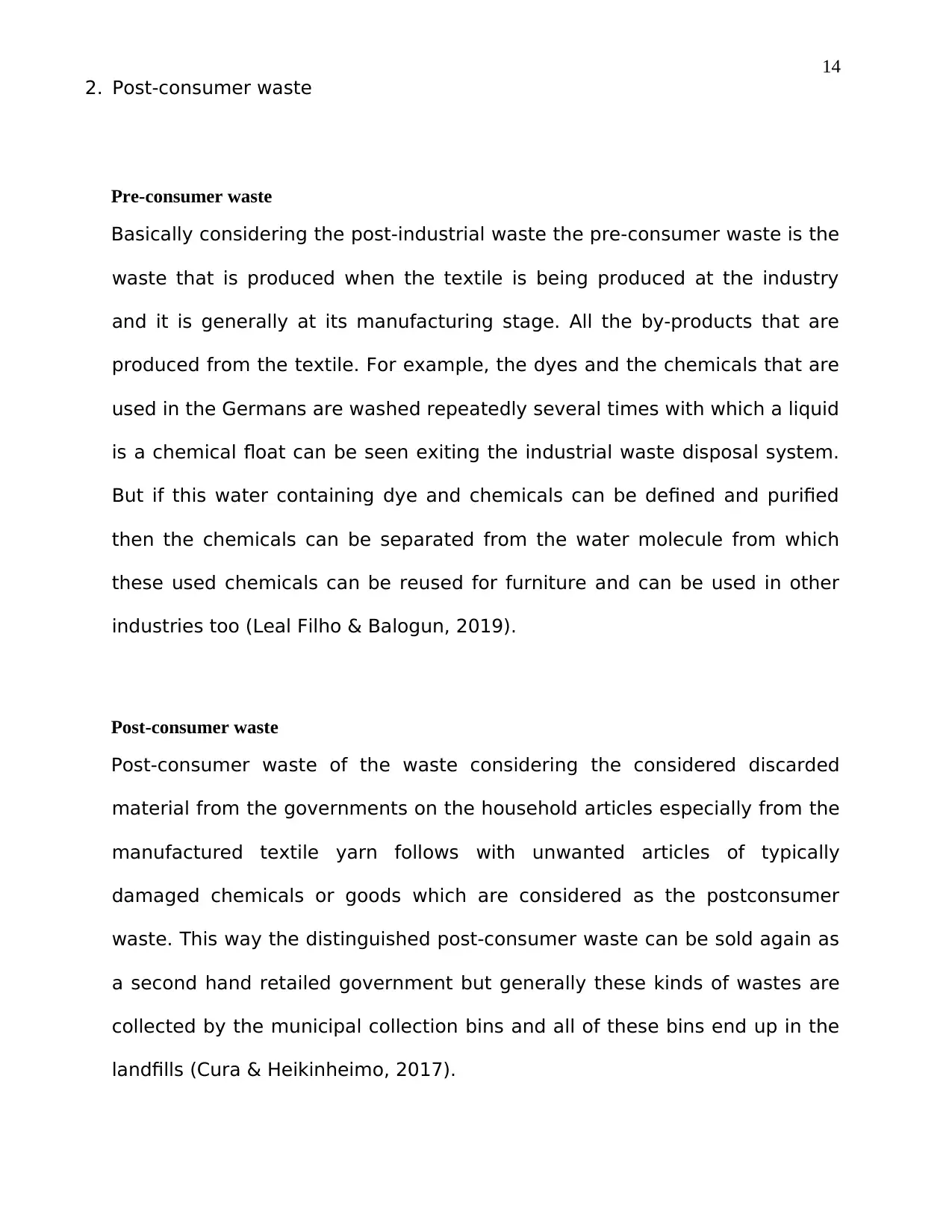
14
2. Post-consumer waste
Pre-consumer waste
Basically considering the post-industrial waste the pre-consumer waste is the
waste that is produced when the textile is being produced at the industry
and it is generally at its manufacturing stage. All the by-products that are
produced from the textile. For example, the dyes and the chemicals that are
used in the Germans are washed repeatedly several times with which a liquid
is a chemical float can be seen exiting the industrial waste disposal system.
But if this water containing dye and chemicals can be defined and purified
then the chemicals can be separated from the water molecule from which
these used chemicals can be reused for furniture and can be used in other
industries too (Leal Filho & Balogun, 2019).
Post-consumer waste
Post-consumer waste of the waste considering the considered discarded
material from the governments on the household articles especially from the
manufactured textile yarn follows with unwanted articles of typically
damaged chemicals or goods which are considered as the postconsumer
waste. This way the distinguished post-consumer waste can be sold again as
a second hand retailed government but generally these kinds of wastes are
collected by the municipal collection bins and all of these bins end up in the
landfills (Cura & Heikinheimo, 2017).
2. Post-consumer waste
Pre-consumer waste
Basically considering the post-industrial waste the pre-consumer waste is the
waste that is produced when the textile is being produced at the industry
and it is generally at its manufacturing stage. All the by-products that are
produced from the textile. For example, the dyes and the chemicals that are
used in the Germans are washed repeatedly several times with which a liquid
is a chemical float can be seen exiting the industrial waste disposal system.
But if this water containing dye and chemicals can be defined and purified
then the chemicals can be separated from the water molecule from which
these used chemicals can be reused for furniture and can be used in other
industries too (Leal Filho & Balogun, 2019).
Post-consumer waste
Post-consumer waste of the waste considering the considered discarded
material from the governments on the household articles especially from the
manufactured textile yarn follows with unwanted articles of typically
damaged chemicals or goods which are considered as the postconsumer
waste. This way the distinguished post-consumer waste can be sold again as
a second hand retailed government but generally these kinds of wastes are
collected by the municipal collection bins and all of these bins end up in the
landfills (Cura & Heikinheimo, 2017).
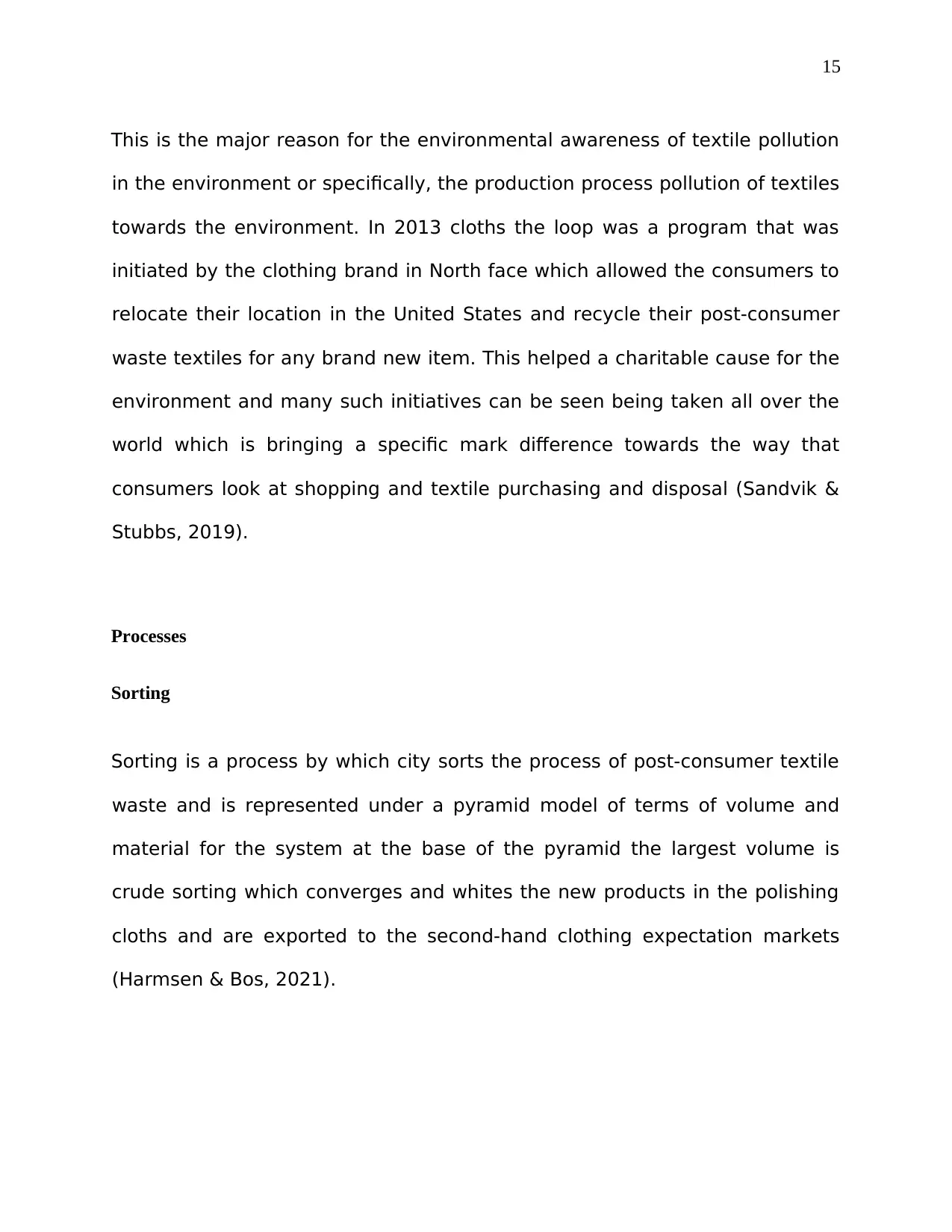
15
This is the major reason for the environmental awareness of textile pollution
in the environment or specifically, the production process pollution of textiles
towards the environment. In 2013 cloths the loop was a program that was
initiated by the clothing brand in North face which allowed the consumers to
relocate their location in the United States and recycle their post-consumer
waste textiles for any brand new item. This helped a charitable cause for the
environment and many such initiatives can be seen being taken all over the
world which is bringing a specific mark difference towards the way that
consumers look at shopping and textile purchasing and disposal (Sandvik &
Stubbs, 2019).
Processes
Sorting
Sorting is a process by which city sorts the process of post-consumer textile
waste and is represented under a pyramid model of terms of volume and
material for the system at the base of the pyramid the largest volume is
crude sorting which converges and whites the new products in the polishing
cloths and are exported to the second-hand clothing expectation markets
(Harmsen & Bos, 2021).
This is the major reason for the environmental awareness of textile pollution
in the environment or specifically, the production process pollution of textiles
towards the environment. In 2013 cloths the loop was a program that was
initiated by the clothing brand in North face which allowed the consumers to
relocate their location in the United States and recycle their post-consumer
waste textiles for any brand new item. This helped a charitable cause for the
environment and many such initiatives can be seen being taken all over the
world which is bringing a specific mark difference towards the way that
consumers look at shopping and textile purchasing and disposal (Sandvik &
Stubbs, 2019).
Processes
Sorting
Sorting is a process by which city sorts the process of post-consumer textile
waste and is represented under a pyramid model of terms of volume and
material for the system at the base of the pyramid the largest volume is
crude sorting which converges and whites the new products in the polishing
cloths and are exported to the second-hand clothing expectation markets
(Harmsen & Bos, 2021).
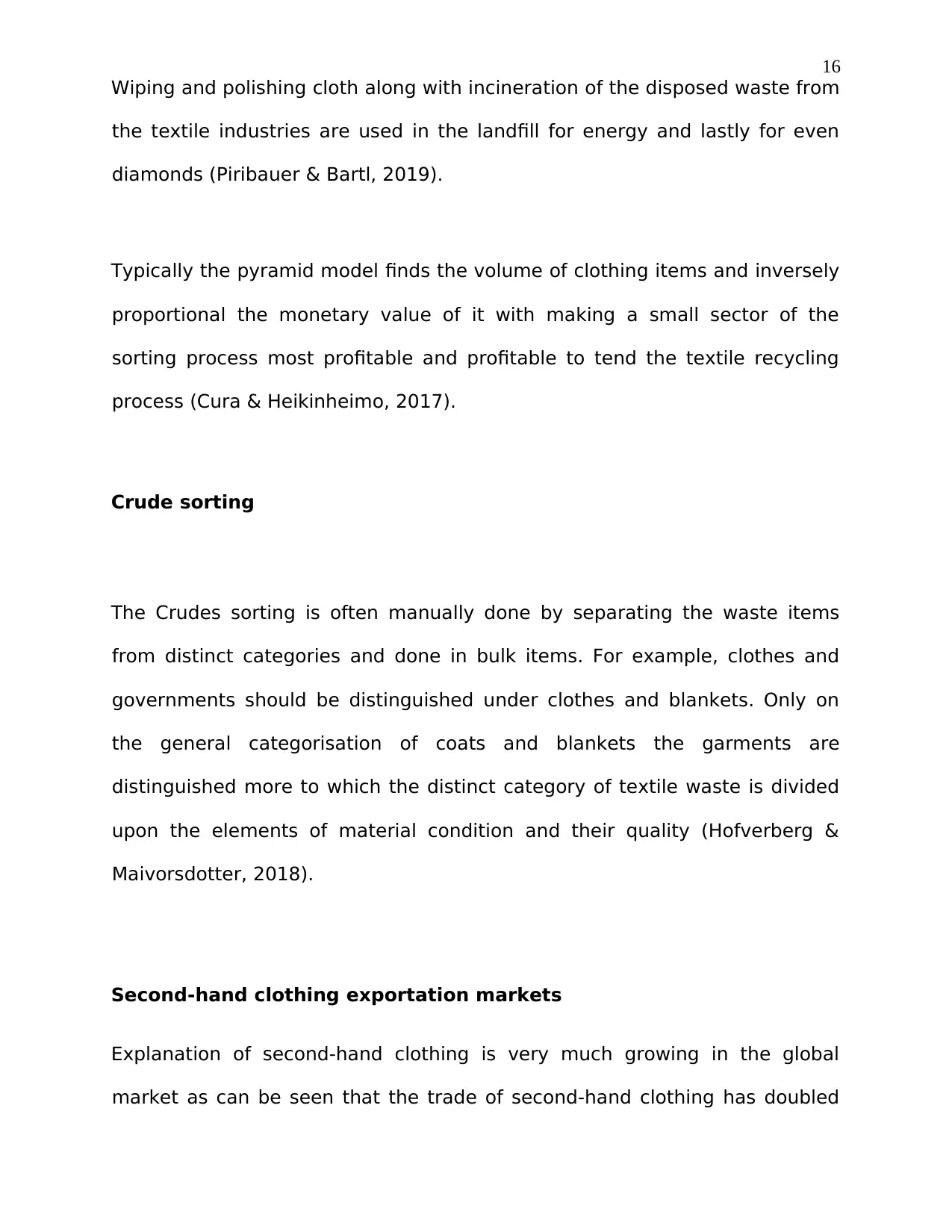
16
Wiping and polishing cloth along with incineration of the disposed waste from
the textile industries are used in the landfill for energy and lastly for even
diamonds (Piribauer & Bartl, 2019).
Typically the pyramid model finds the volume of clothing items and inversely
proportional the monetary value of it with making a small sector of the
sorting process most profitable and profitable to tend the textile recycling
process (Cura & Heikinheimo, 2017).
Crude sorting
The Crudes sorting is often manually done by separating the waste items
from distinct categories and done in bulk items. For example, clothes and
governments should be distinguished under clothes and blankets. Only on
the general categorisation of coats and blankets the garments are
distinguished more to which the distinct category of textile waste is divided
upon the elements of material condition and their quality (Hofverberg &
Maivorsdotter, 2018).
Second-hand clothing exportation markets
Explanation of second-hand clothing is very much growing in the global
market as can be seen that the trade of second-hand clothing has doubled
Wiping and polishing cloth along with incineration of the disposed waste from
the textile industries are used in the landfill for energy and lastly for even
diamonds (Piribauer & Bartl, 2019).
Typically the pyramid model finds the volume of clothing items and inversely
proportional the monetary value of it with making a small sector of the
sorting process most profitable and profitable to tend the textile recycling
process (Cura & Heikinheimo, 2017).
Crude sorting
The Crudes sorting is often manually done by separating the waste items
from distinct categories and done in bulk items. For example, clothes and
governments should be distinguished under clothes and blankets. Only on
the general categorisation of coats and blankets the garments are
distinguished more to which the distinct category of textile waste is divided
upon the elements of material condition and their quality (Hofverberg &
Maivorsdotter, 2018).
Second-hand clothing exportation markets
Explanation of second-hand clothing is very much growing in the global
market as can be seen that the trade of second-hand clothing has doubled
Secure Best Marks with AI Grader
Need help grading? Try our AI Grader for instant feedback on your assignments.
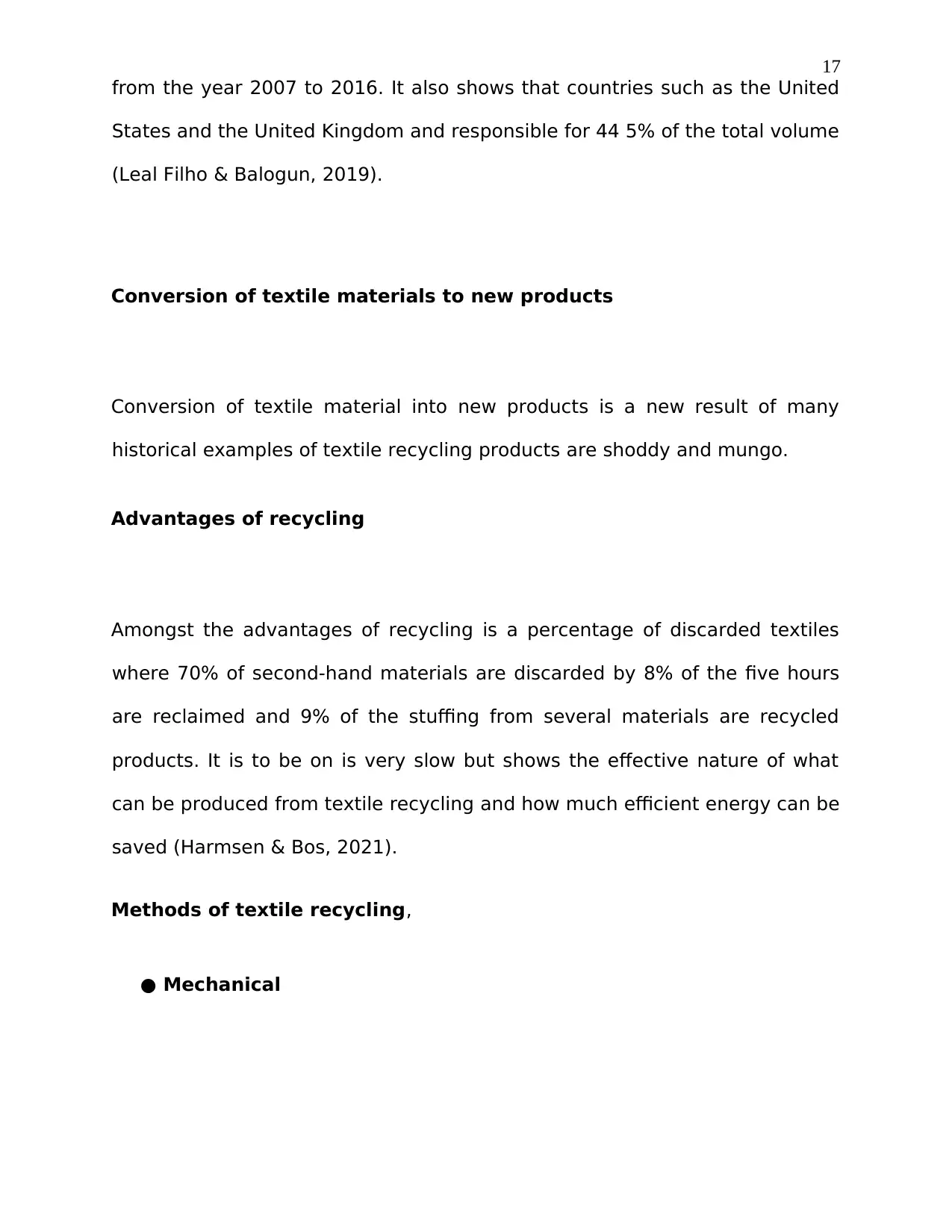
17
from the year 2007 to 2016. It also shows that countries such as the United
States and the United Kingdom and responsible for 44 5% of the total volume
(Leal Filho & Balogun, 2019).
Conversion of textile materials to new products
Conversion of textile material into new products is a new result of many
historical examples of textile recycling products are shoddy and mungo.
Advantages of recycling
Amongst the advantages of recycling is a percentage of discarded textiles
where 70% of second-hand materials are discarded by 8% of the five hours
are reclaimed and 9% of the stuffing from several materials are recycled
products. It is to be on is very slow but shows the effective nature of what
can be produced from textile recycling and how much efficient energy can be
saved (Harmsen & Bos, 2021).
Methods of textile recycling,
● Mechanical
from the year 2007 to 2016. It also shows that countries such as the United
States and the United Kingdom and responsible for 44 5% of the total volume
(Leal Filho & Balogun, 2019).
Conversion of textile materials to new products
Conversion of textile material into new products is a new result of many
historical examples of textile recycling products are shoddy and mungo.
Advantages of recycling
Amongst the advantages of recycling is a percentage of discarded textiles
where 70% of second-hand materials are discarded by 8% of the five hours
are reclaimed and 9% of the stuffing from several materials are recycled
products. It is to be on is very slow but shows the effective nature of what
can be produced from textile recycling and how much efficient energy can be
saved (Harmsen & Bos, 2021).
Methods of textile recycling,
● Mechanical
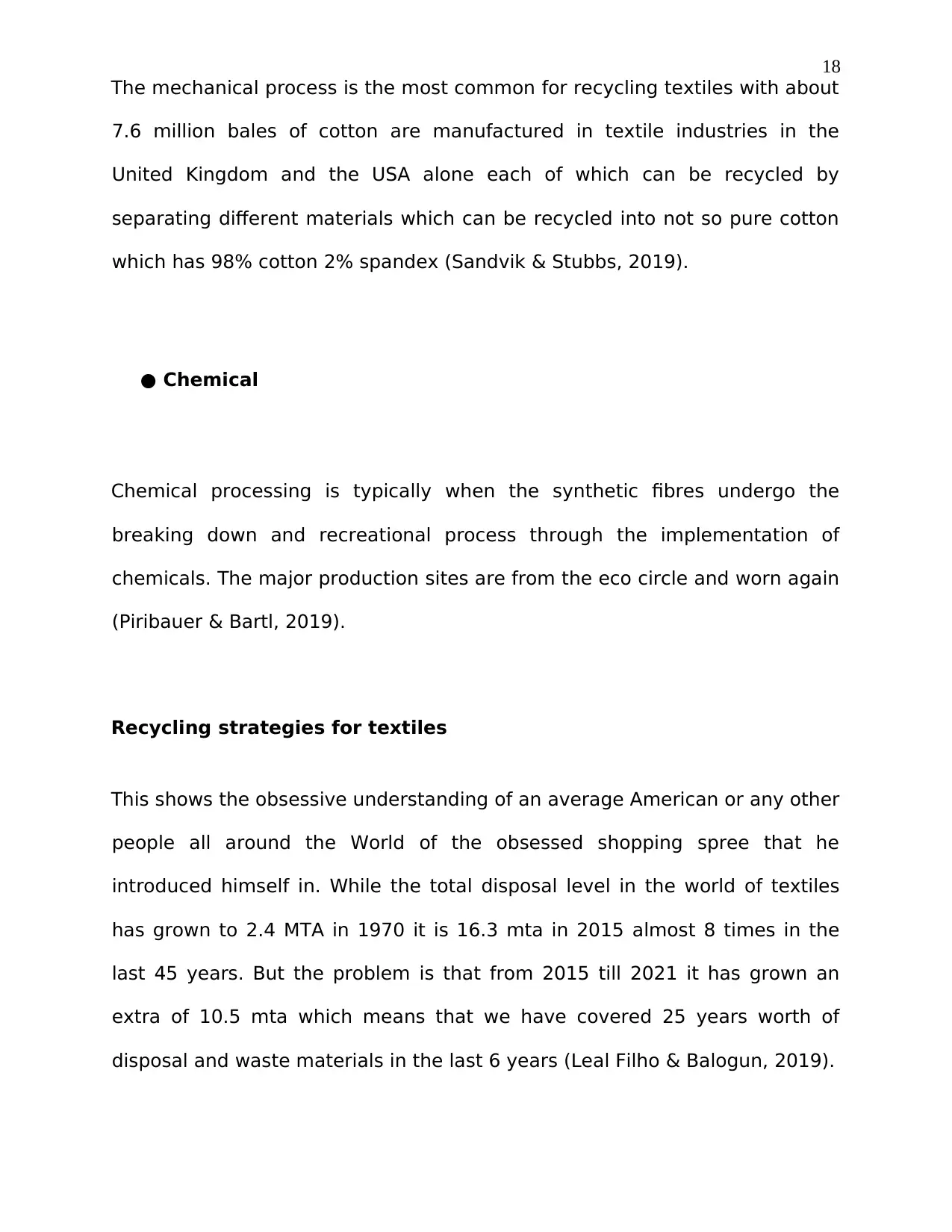
18
The mechanical process is the most common for recycling textiles with about
7.6 million bales of cotton are manufactured in textile industries in the
United Kingdom and the USA alone each of which can be recycled by
separating different materials which can be recycled into not so pure cotton
which has 98% cotton 2% spandex (Sandvik & Stubbs, 2019).
● Chemical
Chemical processing is typically when the synthetic fibres undergo the
breaking down and recreational process through the implementation of
chemicals. The major production sites are from the eco circle and worn again
(Piribauer & Bartl, 2019).
Recycling strategies for textiles
This shows the obsessive understanding of an average American or any other
people all around the World of the obsessed shopping spree that he
introduced himself in. While the total disposal level in the world of textiles
has grown to 2.4 MTA in 1970 it is 16.3 mta in 2015 almost 8 times in the
last 45 years. But the problem is that from 2015 till 2021 it has grown an
extra of 10.5 mta which means that we have covered 25 years worth of
disposal and waste materials in the last 6 years (Leal Filho & Balogun, 2019).
The mechanical process is the most common for recycling textiles with about
7.6 million bales of cotton are manufactured in textile industries in the
United Kingdom and the USA alone each of which can be recycled by
separating different materials which can be recycled into not so pure cotton
which has 98% cotton 2% spandex (Sandvik & Stubbs, 2019).
● Chemical
Chemical processing is typically when the synthetic fibres undergo the
breaking down and recreational process through the implementation of
chemicals. The major production sites are from the eco circle and worn again
(Piribauer & Bartl, 2019).
Recycling strategies for textiles
This shows the obsessive understanding of an average American or any other
people all around the World of the obsessed shopping spree that he
introduced himself in. While the total disposal level in the world of textiles
has grown to 2.4 MTA in 1970 it is 16.3 mta in 2015 almost 8 times in the
last 45 years. But the problem is that from 2015 till 2021 it has grown an
extra of 10.5 mta which means that we have covered 25 years worth of
disposal and waste materials in the last 6 years (Leal Filho & Balogun, 2019).
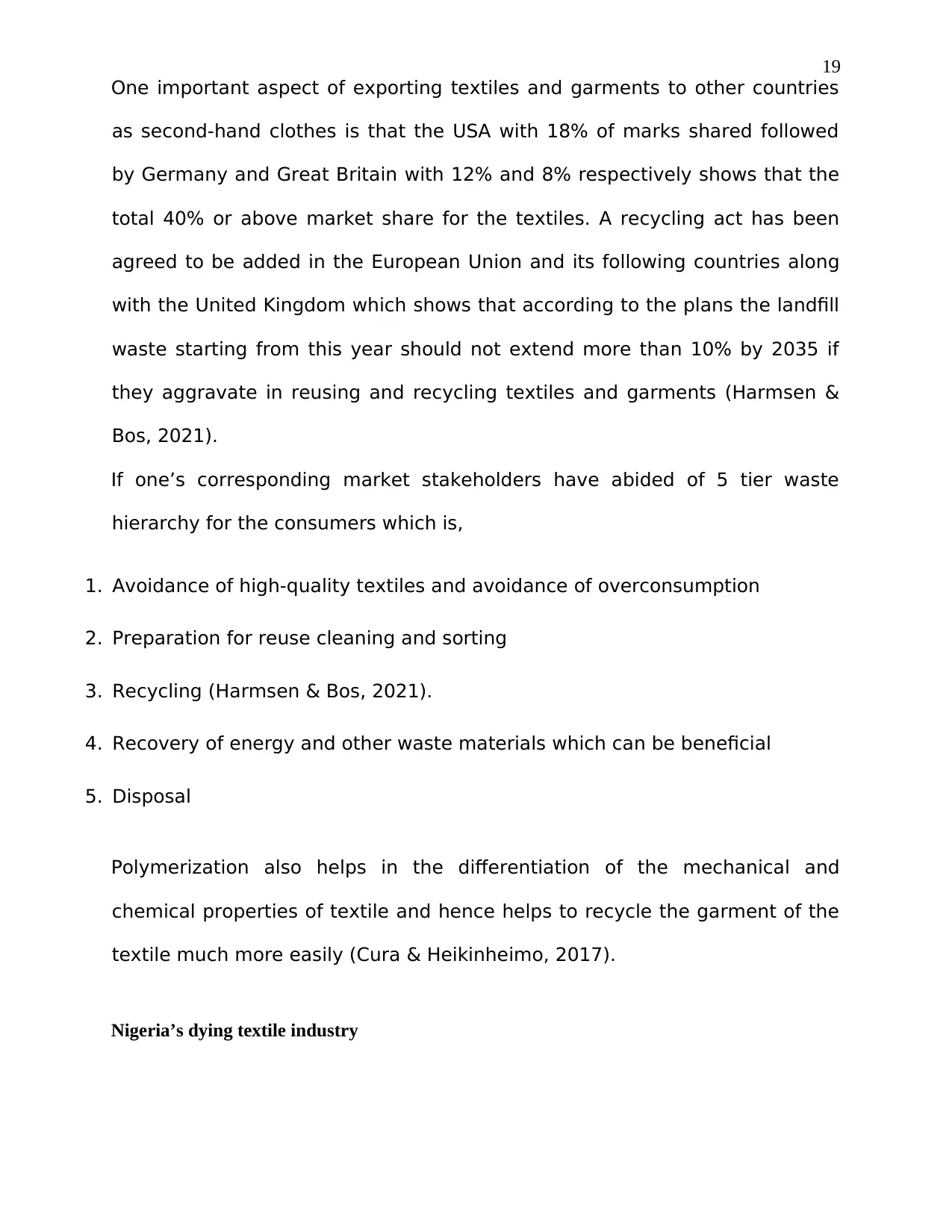
19
One important aspect of exporting textiles and garments to other countries
as second-hand clothes is that the USA with 18% of marks shared followed
by Germany and Great Britain with 12% and 8% respectively shows that the
total 40% or above market share for the textiles. A recycling act has been
agreed to be added in the European Union and its following countries along
with the United Kingdom which shows that according to the plans the landfill
waste starting from this year should not extend more than 10% by 2035 if
they aggravate in reusing and recycling textiles and garments (Harmsen &
Bos, 2021).
If one’s corresponding market stakeholders have abided of 5 tier waste
hierarchy for the consumers which is,
1. Avoidance of high-quality textiles and avoidance of overconsumption
2. Preparation for reuse cleaning and sorting
3. Recycling (Harmsen & Bos, 2021).
4. Recovery of energy and other waste materials which can be beneficial
5. Disposal
Polymerization also helps in the differentiation of the mechanical and
chemical properties of textile and hence helps to recycle the garment of the
textile much more easily (Cura & Heikinheimo, 2017).
Nigeria’s dying textile industry
One important aspect of exporting textiles and garments to other countries
as second-hand clothes is that the USA with 18% of marks shared followed
by Germany and Great Britain with 12% and 8% respectively shows that the
total 40% or above market share for the textiles. A recycling act has been
agreed to be added in the European Union and its following countries along
with the United Kingdom which shows that according to the plans the landfill
waste starting from this year should not extend more than 10% by 2035 if
they aggravate in reusing and recycling textiles and garments (Harmsen &
Bos, 2021).
If one’s corresponding market stakeholders have abided of 5 tier waste
hierarchy for the consumers which is,
1. Avoidance of high-quality textiles and avoidance of overconsumption
2. Preparation for reuse cleaning and sorting
3. Recycling (Harmsen & Bos, 2021).
4. Recovery of energy and other waste materials which can be beneficial
5. Disposal
Polymerization also helps in the differentiation of the mechanical and
chemical properties of textile and hence helps to recycle the garment of the
textile much more easily (Cura & Heikinheimo, 2017).
Nigeria’s dying textile industry
Paraphrase This Document
Need a fresh take? Get an instant paraphrase of this document with our AI Paraphraser
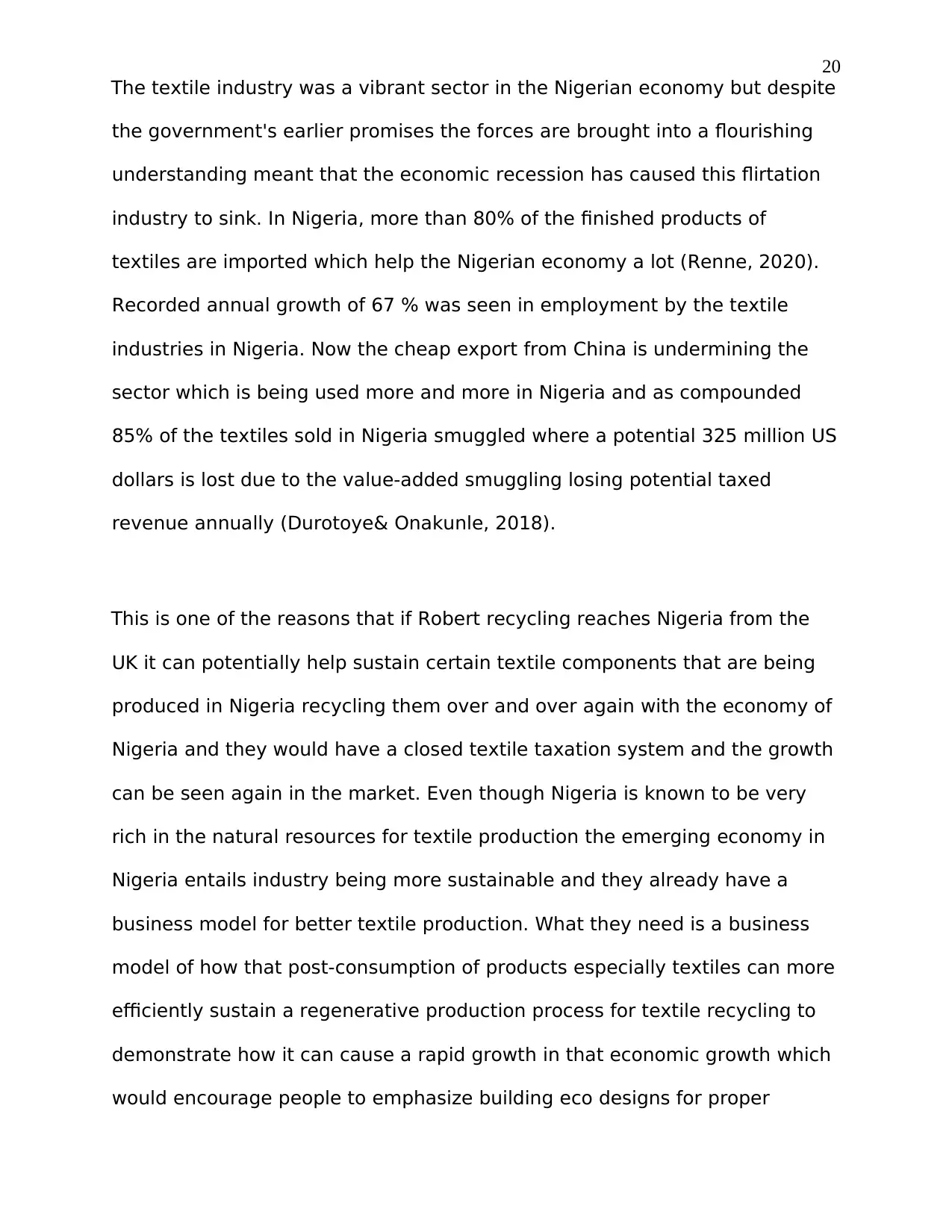
20
The textile industry was a vibrant sector in the Nigerian economy but despite
the government's earlier promises the forces are brought into a flourishing
understanding meant that the economic recession has caused this flirtation
industry to sink. In Nigeria, more than 80% of the finished products of
textiles are imported which help the Nigerian economy a lot (Renne, 2020).
Recorded annual growth of 67 % was seen in employment by the textile
industries in Nigeria. Now the cheap export from China is undermining the
sector which is being used more and more in Nigeria and as compounded
85% of the textiles sold in Nigeria smuggled where a potential 325 million US
dollars is lost due to the value-added smuggling losing potential taxed
revenue annually (Durotoye& Onakunle, 2018).
This is one of the reasons that if Robert recycling reaches Nigeria from the
UK it can potentially help sustain certain textile components that are being
produced in Nigeria recycling them over and over again with the economy of
Nigeria and they would have a closed textile taxation system and the growth
can be seen again in the market. Even though Nigeria is known to be very
rich in the natural resources for textile production the emerging economy in
Nigeria entails industry being more sustainable and they already have a
business model for better textile production. What they need is a business
model of how that post-consumption of products especially textiles can more
efficiently sustain a regenerative production process for textile recycling to
demonstrate how it can cause a rapid growth in that economic growth which
would encourage people to emphasize building eco designs for proper
The textile industry was a vibrant sector in the Nigerian economy but despite
the government's earlier promises the forces are brought into a flourishing
understanding meant that the economic recession has caused this flirtation
industry to sink. In Nigeria, more than 80% of the finished products of
textiles are imported which help the Nigerian economy a lot (Renne, 2020).
Recorded annual growth of 67 % was seen in employment by the textile
industries in Nigeria. Now the cheap export from China is undermining the
sector which is being used more and more in Nigeria and as compounded
85% of the textiles sold in Nigeria smuggled where a potential 325 million US
dollars is lost due to the value-added smuggling losing potential taxed
revenue annually (Durotoye& Onakunle, 2018).
This is one of the reasons that if Robert recycling reaches Nigeria from the
UK it can potentially help sustain certain textile components that are being
produced in Nigeria recycling them over and over again with the economy of
Nigeria and they would have a closed textile taxation system and the growth
can be seen again in the market. Even though Nigeria is known to be very
rich in the natural resources for textile production the emerging economy in
Nigeria entails industry being more sustainable and they already have a
business model for better textile production. What they need is a business
model of how that post-consumption of products especially textiles can more
efficiently sustain a regenerative production process for textile recycling to
demonstrate how it can cause a rapid growth in that economic growth which
would encourage people to emphasize building eco designs for proper
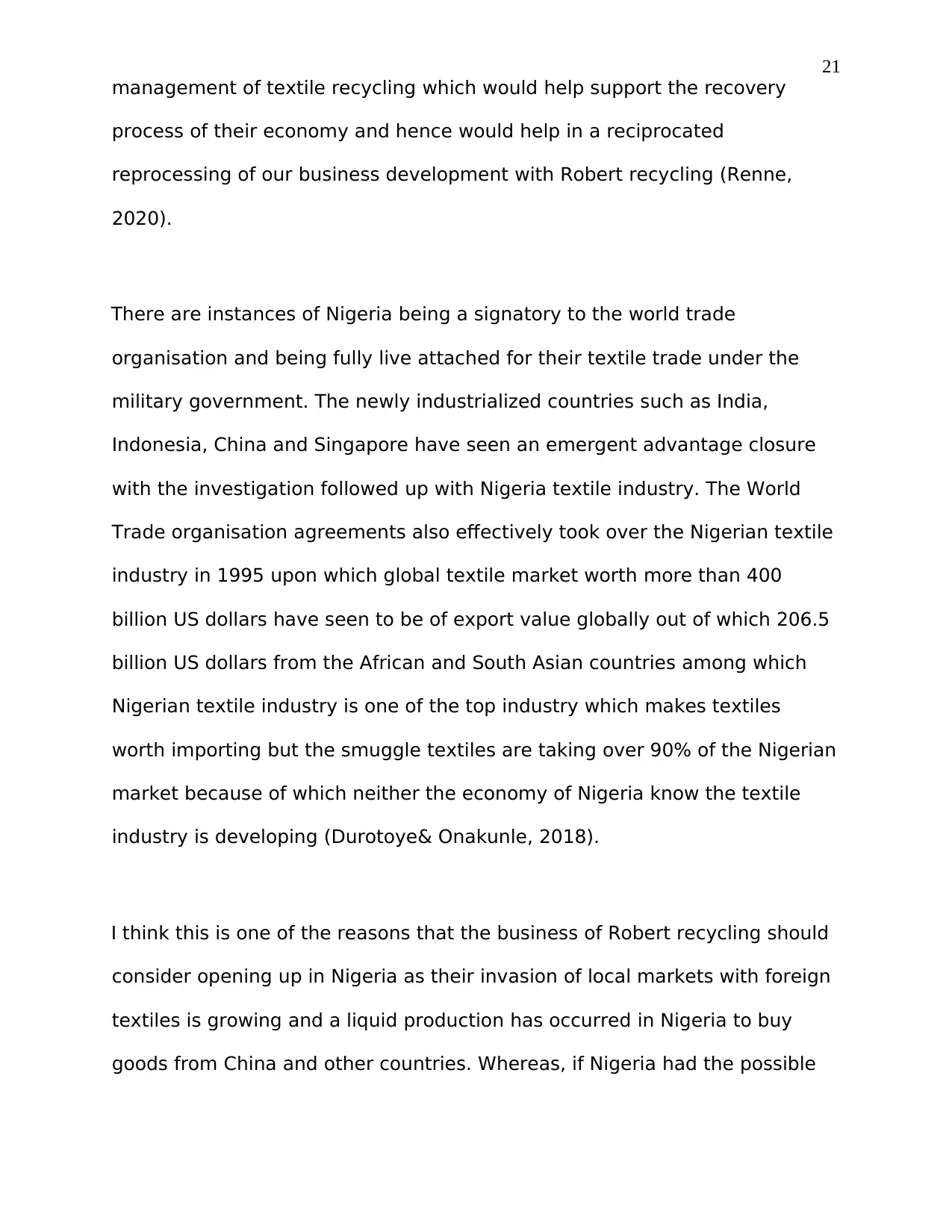
21
management of textile recycling which would help support the recovery
process of their economy and hence would help in a reciprocated
reprocessing of our business development with Robert recycling (Renne,
2020).
There are instances of Nigeria being a signatory to the world trade
organisation and being fully live attached for their textile trade under the
military government. The newly industrialized countries such as India,
Indonesia, China and Singapore have seen an emergent advantage closure
with the investigation followed up with Nigeria textile industry. The World
Trade organisation agreements also effectively took over the Nigerian textile
industry in 1995 upon which global textile market worth more than 400
billion US dollars have seen to be of export value globally out of which 206.5
billion US dollars from the African and South Asian countries among which
Nigerian textile industry is one of the top industry which makes textiles
worth importing but the smuggle textiles are taking over 90% of the Nigerian
market because of which neither the economy of Nigeria know the textile
industry is developing (Durotoye& Onakunle, 2018).
I think this is one of the reasons that the business of Robert recycling should
consider opening up in Nigeria as their invasion of local markets with foreign
textiles is growing and a liquid production has occurred in Nigeria to buy
goods from China and other countries. Whereas, if Nigeria had the possible
management of textile recycling which would help support the recovery
process of their economy and hence would help in a reciprocated
reprocessing of our business development with Robert recycling (Renne,
2020).
There are instances of Nigeria being a signatory to the world trade
organisation and being fully live attached for their textile trade under the
military government. The newly industrialized countries such as India,
Indonesia, China and Singapore have seen an emergent advantage closure
with the investigation followed up with Nigeria textile industry. The World
Trade organisation agreements also effectively took over the Nigerian textile
industry in 1995 upon which global textile market worth more than 400
billion US dollars have seen to be of export value globally out of which 206.5
billion US dollars from the African and South Asian countries among which
Nigerian textile industry is one of the top industry which makes textiles
worth importing but the smuggle textiles are taking over 90% of the Nigerian
market because of which neither the economy of Nigeria know the textile
industry is developing (Durotoye& Onakunle, 2018).
I think this is one of the reasons that the business of Robert recycling should
consider opening up in Nigeria as their invasion of local markets with foreign
textiles is growing and a liquid production has occurred in Nigeria to buy
goods from China and other countries. Whereas, if Nigeria had the possible
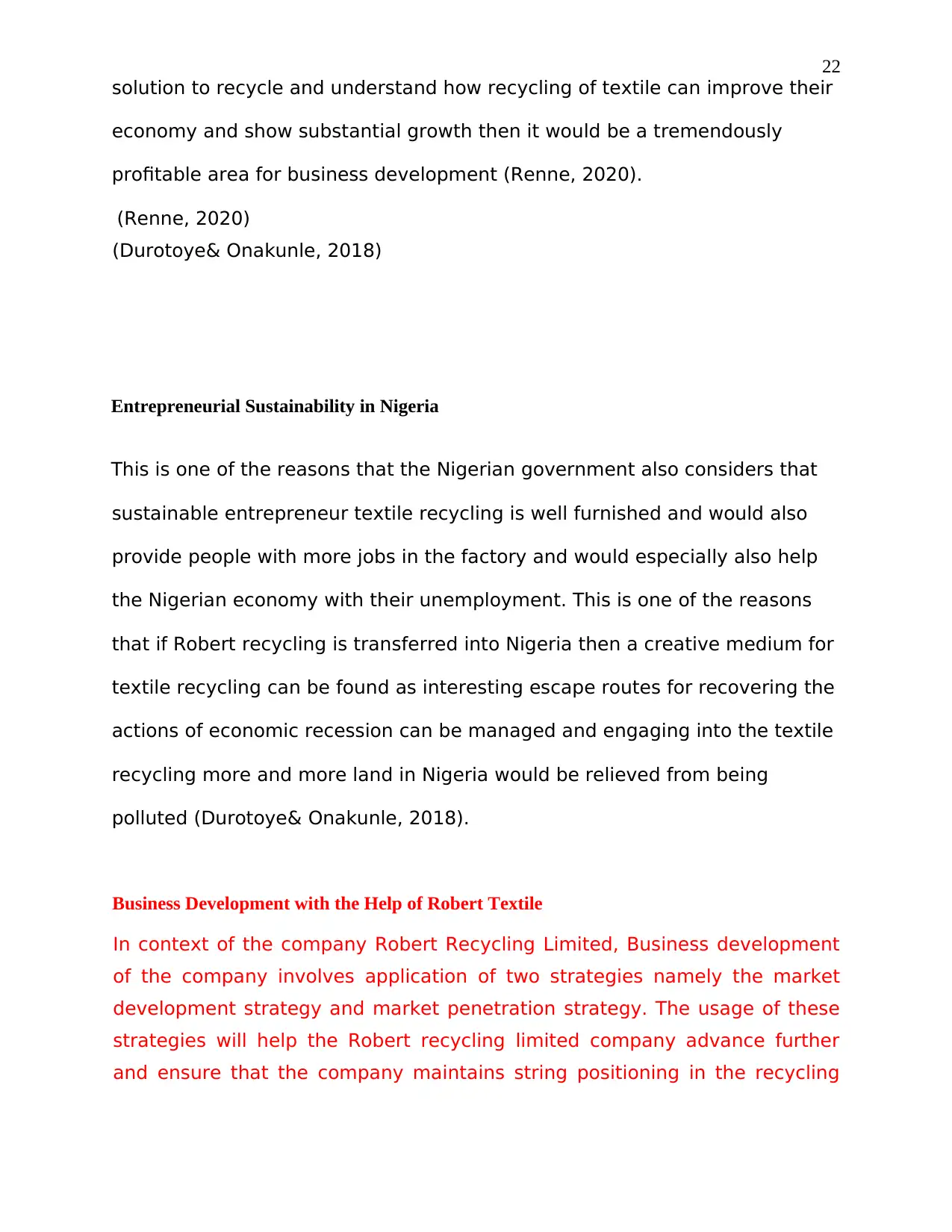
22
solution to recycle and understand how recycling of textile can improve their
economy and show substantial growth then it would be a tremendously
profitable area for business development (Renne, 2020).
(Renne, 2020)
(Durotoye& Onakunle, 2018)
Entrepreneurial Sustainability in Nigeria
This is one of the reasons that the Nigerian government also considers that
sustainable entrepreneur textile recycling is well furnished and would also
provide people with more jobs in the factory and would especially also help
the Nigerian economy with their unemployment. This is one of the reasons
that if Robert recycling is transferred into Nigeria then a creative medium for
textile recycling can be found as interesting escape routes for recovering the
actions of economic recession can be managed and engaging into the textile
recycling more and more land in Nigeria would be relieved from being
polluted (Durotoye& Onakunle, 2018).
Business Development with the Help of Robert Textile
In context of the company Robert Recycling Limited, Business development
of the company involves application of two strategies namely the market
development strategy and market penetration strategy. The usage of these
strategies will help the Robert recycling limited company advance further
and ensure that the company maintains string positioning in the recycling
solution to recycle and understand how recycling of textile can improve their
economy and show substantial growth then it would be a tremendously
profitable area for business development (Renne, 2020).
(Renne, 2020)
(Durotoye& Onakunle, 2018)
Entrepreneurial Sustainability in Nigeria
This is one of the reasons that the Nigerian government also considers that
sustainable entrepreneur textile recycling is well furnished and would also
provide people with more jobs in the factory and would especially also help
the Nigerian economy with their unemployment. This is one of the reasons
that if Robert recycling is transferred into Nigeria then a creative medium for
textile recycling can be found as interesting escape routes for recovering the
actions of economic recession can be managed and engaging into the textile
recycling more and more land in Nigeria would be relieved from being
polluted (Durotoye& Onakunle, 2018).
Business Development with the Help of Robert Textile
In context of the company Robert Recycling Limited, Business development
of the company involves application of two strategies namely the market
development strategy and market penetration strategy. The usage of these
strategies will help the Robert recycling limited company advance further
and ensure that the company maintains string positioning in the recycling
Secure Best Marks with AI Grader
Need help grading? Try our AI Grader for instant feedback on your assignments.
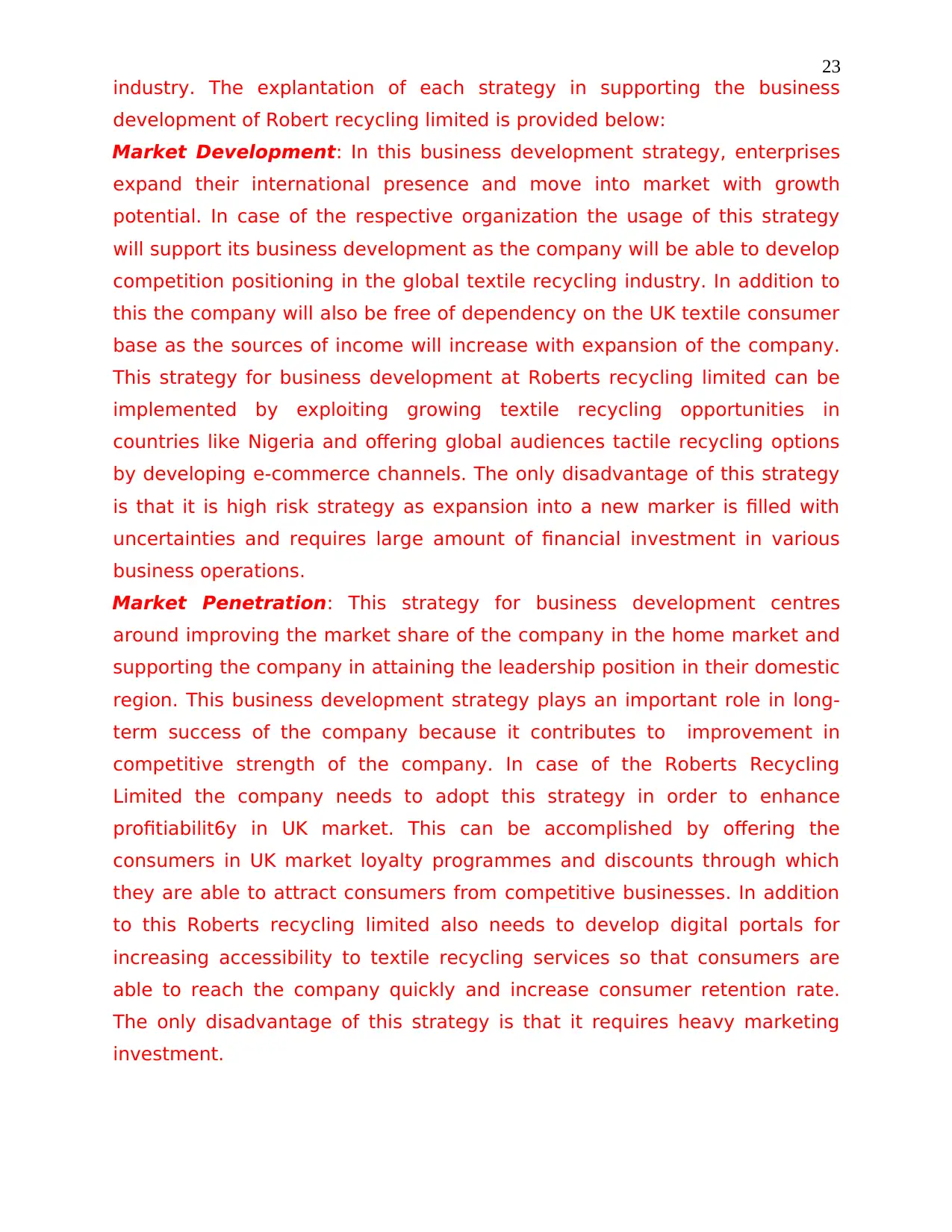
23
industry. The explantation of each strategy in supporting the business
development of Robert recycling limited is provided below:
Market Development: In this business development strategy, enterprises
expand their international presence and move into market with growth
potential. In case of the respective organization the usage of this strategy
will support its business development as the company will be able to develop
competition positioning in the global textile recycling industry. In addition to
this the company will also be free of dependency on the UK textile consumer
base as the sources of income will increase with expansion of the company.
This strategy for business development at Roberts recycling limited can be
implemented by exploiting growing textile recycling opportunities in
countries like Nigeria and offering global audiences tactile recycling options
by developing e-commerce channels. The only disadvantage of this strategy
is that it is high risk strategy as expansion into a new marker is filled with
uncertainties and requires large amount of financial investment in various
business operations.
Market Penetration: This strategy for business development centres
around improving the market share of the company in the home market and
supporting the company in attaining the leadership position in their domestic
region. This business development strategy plays an important role in long-
term success of the company because it contributes to improvement in
competitive strength of the company. In case of the Roberts Recycling
Limited the company needs to adopt this strategy in order to enhance
profitiabilit6y in UK market. This can be accomplished by offering the
consumers in UK market loyalty programmes and discounts through which
they are able to attract consumers from competitive businesses. In addition
to this Roberts recycling limited also needs to develop digital portals for
increasing accessibility to textile recycling services so that consumers are
able to reach the company quickly and increase consumer retention rate.
The only disadvantage of this strategy is that it requires heavy marketing
investment.
industry. The explantation of each strategy in supporting the business
development of Robert recycling limited is provided below:
Market Development: In this business development strategy, enterprises
expand their international presence and move into market with growth
potential. In case of the respective organization the usage of this strategy
will support its business development as the company will be able to develop
competition positioning in the global textile recycling industry. In addition to
this the company will also be free of dependency on the UK textile consumer
base as the sources of income will increase with expansion of the company.
This strategy for business development at Roberts recycling limited can be
implemented by exploiting growing textile recycling opportunities in
countries like Nigeria and offering global audiences tactile recycling options
by developing e-commerce channels. The only disadvantage of this strategy
is that it is high risk strategy as expansion into a new marker is filled with
uncertainties and requires large amount of financial investment in various
business operations.
Market Penetration: This strategy for business development centres
around improving the market share of the company in the home market and
supporting the company in attaining the leadership position in their domestic
region. This business development strategy plays an important role in long-
term success of the company because it contributes to improvement in
competitive strength of the company. In case of the Roberts Recycling
Limited the company needs to adopt this strategy in order to enhance
profitiabilit6y in UK market. This can be accomplished by offering the
consumers in UK market loyalty programmes and discounts through which
they are able to attract consumers from competitive businesses. In addition
to this Roberts recycling limited also needs to develop digital portals for
increasing accessibility to textile recycling services so that consumers are
able to reach the company quickly and increase consumer retention rate.
The only disadvantage of this strategy is that it requires heavy marketing
investment.
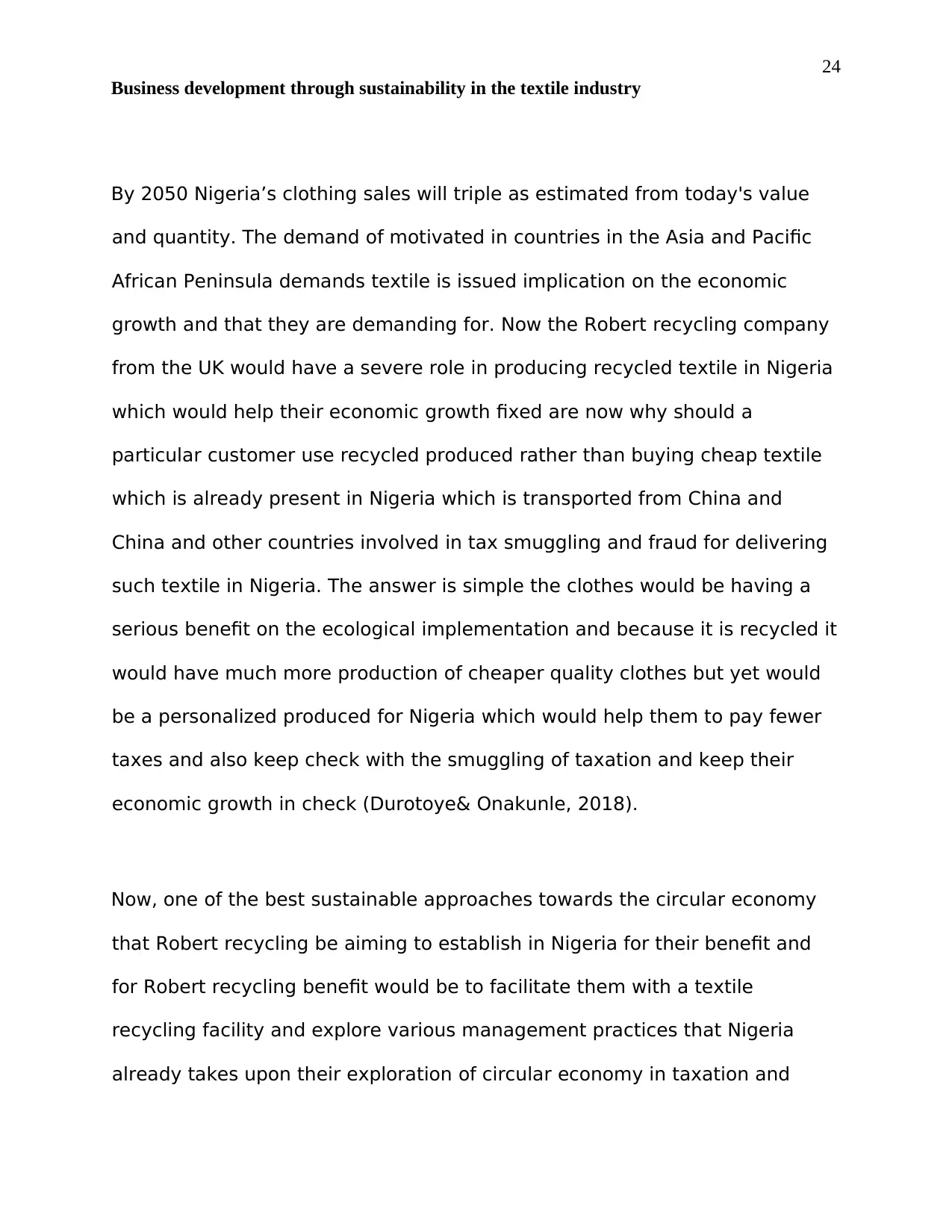
24
Business development through sustainability in the textile industry
By 2050 Nigeria’s clothing sales will triple as estimated from today's value
and quantity. The demand of motivated in countries in the Asia and Pacific
African Peninsula demands textile is issued implication on the economic
growth and that they are demanding for. Now the Robert recycling company
from the UK would have a severe role in producing recycled textile in Nigeria
which would help their economic growth fixed are now why should a
particular customer use recycled produced rather than buying cheap textile
which is already present in Nigeria which is transported from China and
China and other countries involved in tax smuggling and fraud for delivering
such textile in Nigeria. The answer is simple the clothes would be having a
serious benefit on the ecological implementation and because it is recycled it
would have much more production of cheaper quality clothes but yet would
be a personalized produced for Nigeria which would help them to pay fewer
taxes and also keep check with the smuggling of taxation and keep their
economic growth in check (Durotoye& Onakunle, 2018).
Now, one of the best sustainable approaches towards the circular economy
that Robert recycling be aiming to establish in Nigeria for their benefit and
for Robert recycling benefit would be to facilitate them with a textile
recycling facility and explore various management practices that Nigeria
already takes upon their exploration of circular economy in taxation and
Business development through sustainability in the textile industry
By 2050 Nigeria’s clothing sales will triple as estimated from today's value
and quantity. The demand of motivated in countries in the Asia and Pacific
African Peninsula demands textile is issued implication on the economic
growth and that they are demanding for. Now the Robert recycling company
from the UK would have a severe role in producing recycled textile in Nigeria
which would help their economic growth fixed are now why should a
particular customer use recycled produced rather than buying cheap textile
which is already present in Nigeria which is transported from China and
China and other countries involved in tax smuggling and fraud for delivering
such textile in Nigeria. The answer is simple the clothes would be having a
serious benefit on the ecological implementation and because it is recycled it
would have much more production of cheaper quality clothes but yet would
be a personalized produced for Nigeria which would help them to pay fewer
taxes and also keep check with the smuggling of taxation and keep their
economic growth in check (Durotoye& Onakunle, 2018).
Now, one of the best sustainable approaches towards the circular economy
that Robert recycling be aiming to establish in Nigeria for their benefit and
for Robert recycling benefit would be to facilitate them with a textile
recycling facility and explore various management practices that Nigeria
already takes upon their exploration of circular economy in taxation and
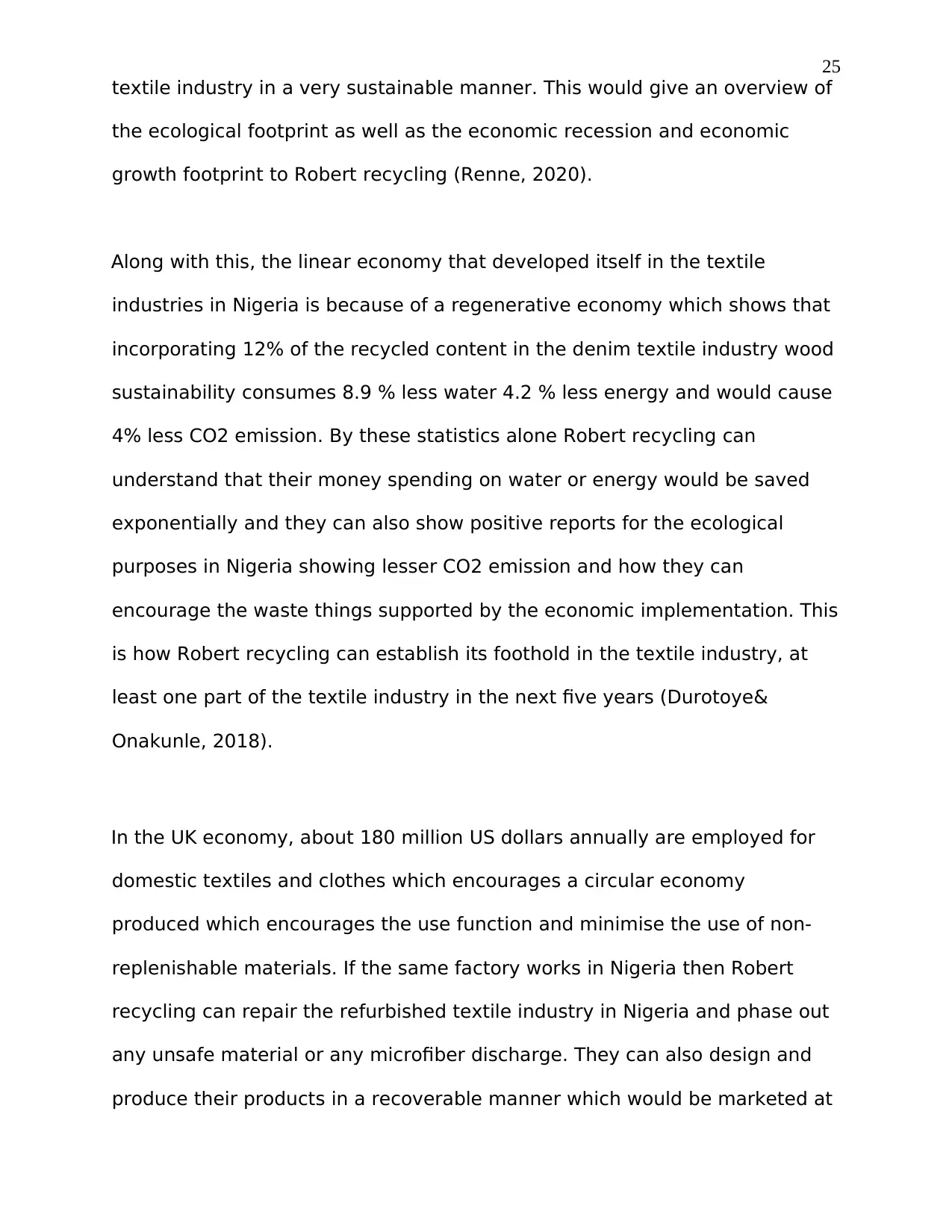
25
textile industry in a very sustainable manner. This would give an overview of
the ecological footprint as well as the economic recession and economic
growth footprint to Robert recycling (Renne, 2020).
Along with this, the linear economy that developed itself in the textile
industries in Nigeria is because of a regenerative economy which shows that
incorporating 12% of the recycled content in the denim textile industry wood
sustainability consumes 8.9 % less water 4.2 % less energy and would cause
4% less CO2 emission. By these statistics alone Robert recycling can
understand that their money spending on water or energy would be saved
exponentially and they can also show positive reports for the ecological
purposes in Nigeria showing lesser CO2 emission and how they can
encourage the waste things supported by the economic implementation. This
is how Robert recycling can establish its foothold in the textile industry, at
least one part of the textile industry in the next five years (Durotoye&
Onakunle, 2018).
In the UK economy, about 180 million US dollars annually are employed for
domestic textiles and clothes which encourages a circular economy
produced which encourages the use function and minimise the use of non-
replenishable materials. If the same factory works in Nigeria then Robert
recycling can repair the refurbished textile industry in Nigeria and phase out
any unsafe material or any microfiber discharge. They can also design and
produce their products in a recoverable manner which would be marketed at
textile industry in a very sustainable manner. This would give an overview of
the ecological footprint as well as the economic recession and economic
growth footprint to Robert recycling (Renne, 2020).
Along with this, the linear economy that developed itself in the textile
industries in Nigeria is because of a regenerative economy which shows that
incorporating 12% of the recycled content in the denim textile industry wood
sustainability consumes 8.9 % less water 4.2 % less energy and would cause
4% less CO2 emission. By these statistics alone Robert recycling can
understand that their money spending on water or energy would be saved
exponentially and they can also show positive reports for the ecological
purposes in Nigeria showing lesser CO2 emission and how they can
encourage the waste things supported by the economic implementation. This
is how Robert recycling can establish its foothold in the textile industry, at
least one part of the textile industry in the next five years (Durotoye&
Onakunle, 2018).
In the UK economy, about 180 million US dollars annually are employed for
domestic textiles and clothes which encourages a circular economy
produced which encourages the use function and minimise the use of non-
replenishable materials. If the same factory works in Nigeria then Robert
recycling can repair the refurbished textile industry in Nigeria and phase out
any unsafe material or any microfiber discharge. They can also design and
produce their products in a recoverable manner which would be marketed at
Paraphrase This Document
Need a fresh take? Get an instant paraphrase of this document with our AI Paraphraser
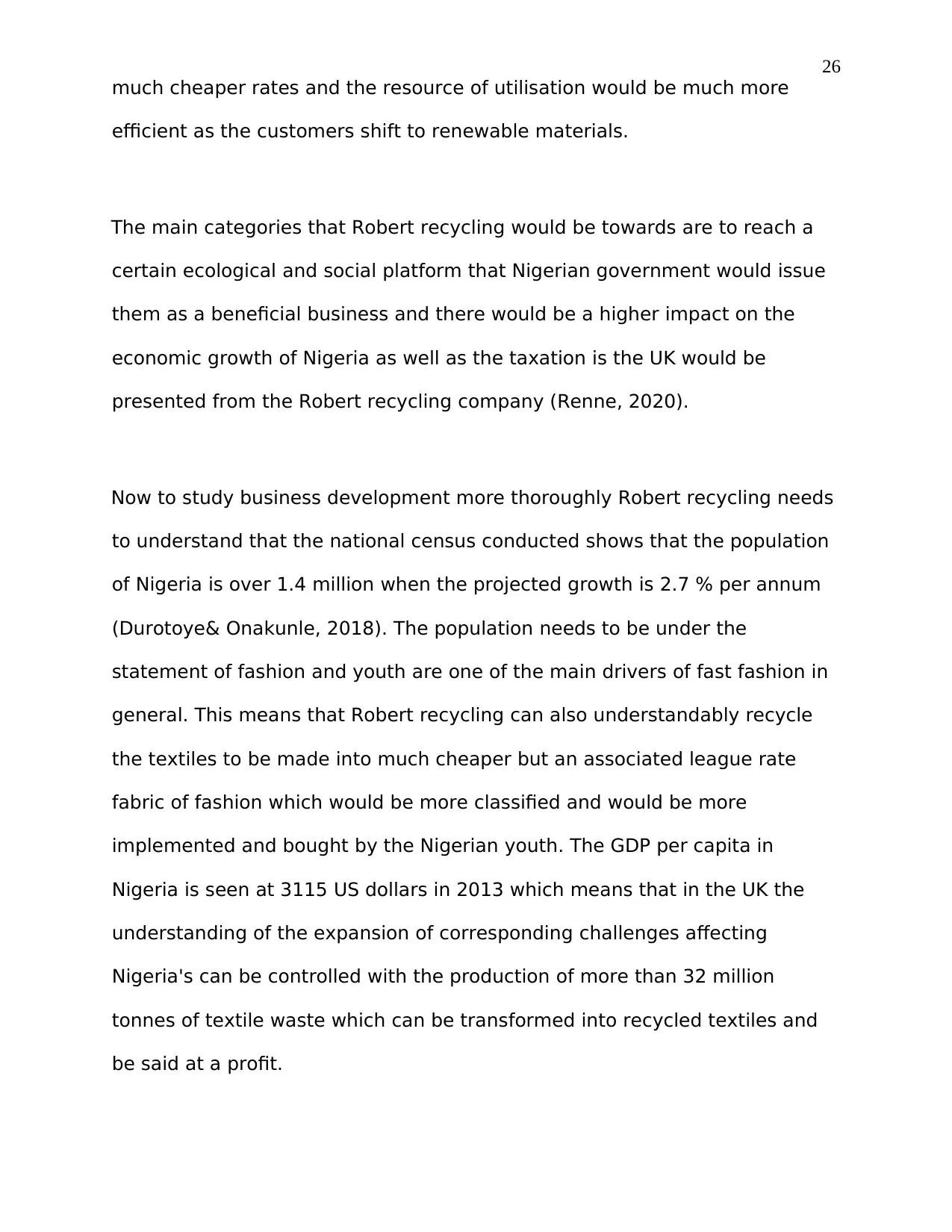
26
much cheaper rates and the resource of utilisation would be much more
efficient as the customers shift to renewable materials.
The main categories that Robert recycling would be towards are to reach a
certain ecological and social platform that Nigerian government would issue
them as a beneficial business and there would be a higher impact on the
economic growth of Nigeria as well as the taxation is the UK would be
presented from the Robert recycling company (Renne, 2020).
Now to study business development more thoroughly Robert recycling needs
to understand that the national census conducted shows that the population
of Nigeria is over 1.4 million when the projected growth is 2.7 % per annum
(Durotoye& Onakunle, 2018). The population needs to be under the
statement of fashion and youth are one of the main drivers of fast fashion in
general. This means that Robert recycling can also understandably recycle
the textiles to be made into much cheaper but an associated league rate
fabric of fashion which would be more classified and would be more
implemented and bought by the Nigerian youth. The GDP per capita in
Nigeria is seen at 3115 US dollars in 2013 which means that in the UK the
understanding of the expansion of corresponding challenges affecting
Nigeria's can be controlled with the production of more than 32 million
tonnes of textile waste which can be transformed into recycled textiles and
be said at a profit.
much cheaper rates and the resource of utilisation would be much more
efficient as the customers shift to renewable materials.
The main categories that Robert recycling would be towards are to reach a
certain ecological and social platform that Nigerian government would issue
them as a beneficial business and there would be a higher impact on the
economic growth of Nigeria as well as the taxation is the UK would be
presented from the Robert recycling company (Renne, 2020).
Now to study business development more thoroughly Robert recycling needs
to understand that the national census conducted shows that the population
of Nigeria is over 1.4 million when the projected growth is 2.7 % per annum
(Durotoye& Onakunle, 2018). The population needs to be under the
statement of fashion and youth are one of the main drivers of fast fashion in
general. This means that Robert recycling can also understandably recycle
the textiles to be made into much cheaper but an associated league rate
fabric of fashion which would be more classified and would be more
implemented and bought by the Nigerian youth. The GDP per capita in
Nigeria is seen at 3115 US dollars in 2013 which means that in the UK the
understanding of the expansion of corresponding challenges affecting
Nigeria's can be controlled with the production of more than 32 million
tonnes of textile waste which can be transformed into recycled textiles and
be said at a profit.
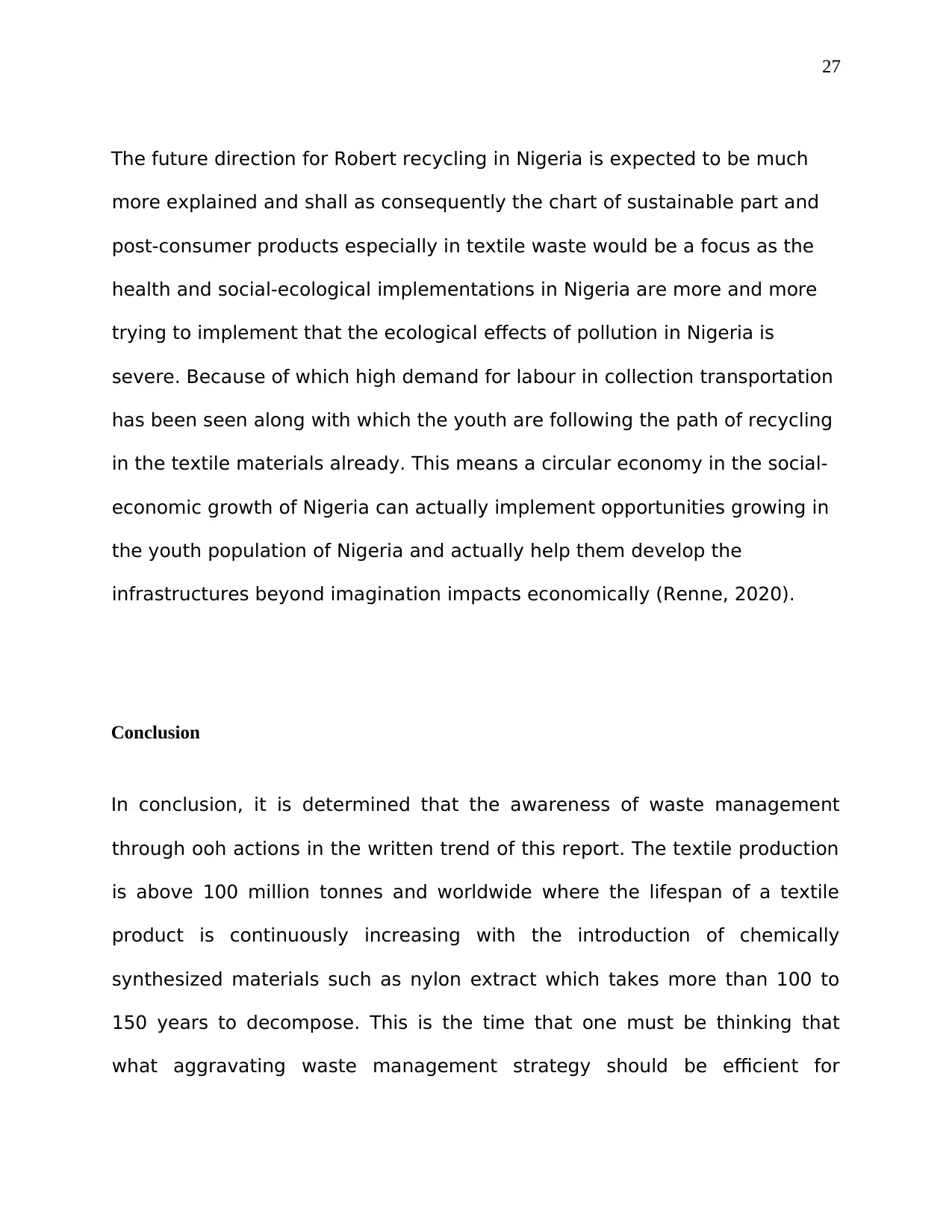
27
The future direction for Robert recycling in Nigeria is expected to be much
more explained and shall as consequently the chart of sustainable part and
post-consumer products especially in textile waste would be a focus as the
health and social-ecological implementations in Nigeria are more and more
trying to implement that the ecological effects of pollution in Nigeria is
severe. Because of which high demand for labour in collection transportation
has been seen along with which the youth are following the path of recycling
in the textile materials already. This means a circular economy in the social-
economic growth of Nigeria can actually implement opportunities growing in
the youth population of Nigeria and actually help them develop the
infrastructures beyond imagination impacts economically (Renne, 2020).
Conclusion
In conclusion, it is determined that the awareness of waste management
through ooh actions in the written trend of this report. The textile production
is above 100 million tonnes and worldwide where the lifespan of a textile
product is continuously increasing with the introduction of chemically
synthesized materials such as nylon extract which takes more than 100 to
150 years to decompose. This is the time that one must be thinking that
what aggravating waste management strategy should be efficient for
The future direction for Robert recycling in Nigeria is expected to be much
more explained and shall as consequently the chart of sustainable part and
post-consumer products especially in textile waste would be a focus as the
health and social-ecological implementations in Nigeria are more and more
trying to implement that the ecological effects of pollution in Nigeria is
severe. Because of which high demand for labour in collection transportation
has been seen along with which the youth are following the path of recycling
in the textile materials already. This means a circular economy in the social-
economic growth of Nigeria can actually implement opportunities growing in
the youth population of Nigeria and actually help them develop the
infrastructures beyond imagination impacts economically (Renne, 2020).
Conclusion
In conclusion, it is determined that the awareness of waste management
through ooh actions in the written trend of this report. The textile production
is above 100 million tonnes and worldwide where the lifespan of a textile
product is continuously increasing with the introduction of chemically
synthesized materials such as nylon extract which takes more than 100 to
150 years to decompose. This is the time that one must be thinking that
what aggravating waste management strategy should be efficient for
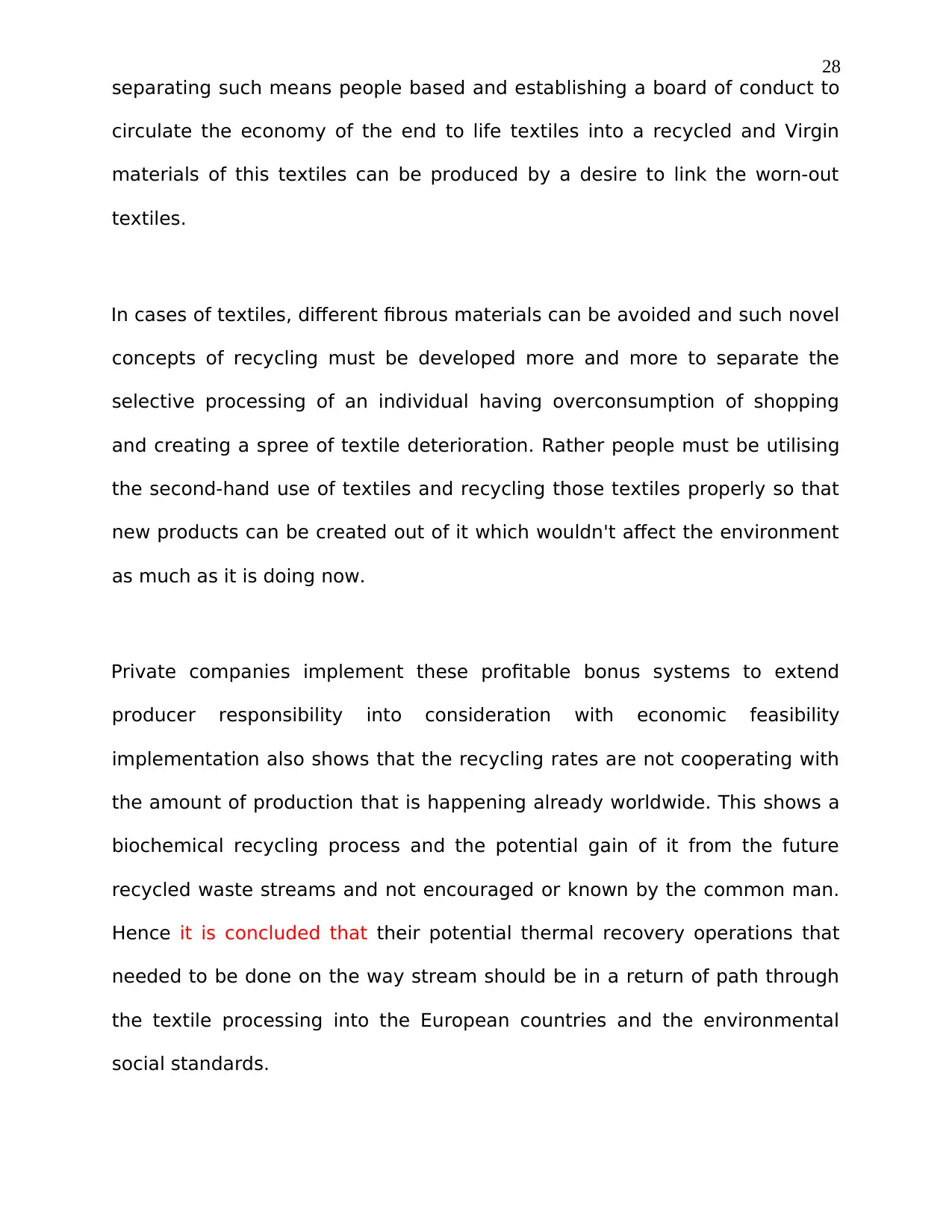
28
separating such means people based and establishing a board of conduct to
circulate the economy of the end to life textiles into a recycled and Virgin
materials of this textiles can be produced by a desire to link the worn-out
textiles.
In cases of textiles, different fibrous materials can be avoided and such novel
concepts of recycling must be developed more and more to separate the
selective processing of an individual having overconsumption of shopping
and creating a spree of textile deterioration. Rather people must be utilising
the second-hand use of textiles and recycling those textiles properly so that
new products can be created out of it which wouldn't affect the environment
as much as it is doing now.
Private companies implement these profitable bonus systems to extend
producer responsibility into consideration with economic feasibility
implementation also shows that the recycling rates are not cooperating with
the amount of production that is happening already worldwide. This shows a
biochemical recycling process and the potential gain of it from the future
recycled waste streams and not encouraged or known by the common man.
Hence it is concluded that their potential thermal recovery operations that
needed to be done on the way stream should be in a return of path through
the textile processing into the European countries and the environmental
social standards.
separating such means people based and establishing a board of conduct to
circulate the economy of the end to life textiles into a recycled and Virgin
materials of this textiles can be produced by a desire to link the worn-out
textiles.
In cases of textiles, different fibrous materials can be avoided and such novel
concepts of recycling must be developed more and more to separate the
selective processing of an individual having overconsumption of shopping
and creating a spree of textile deterioration. Rather people must be utilising
the second-hand use of textiles and recycling those textiles properly so that
new products can be created out of it which wouldn't affect the environment
as much as it is doing now.
Private companies implement these profitable bonus systems to extend
producer responsibility into consideration with economic feasibility
implementation also shows that the recycling rates are not cooperating with
the amount of production that is happening already worldwide. This shows a
biochemical recycling process and the potential gain of it from the future
recycled waste streams and not encouraged or known by the common man.
Hence it is concluded that their potential thermal recovery operations that
needed to be done on the way stream should be in a return of path through
the textile processing into the European countries and the environmental
social standards.
Secure Best Marks with AI Grader
Need help grading? Try our AI Grader for instant feedback on your assignments.
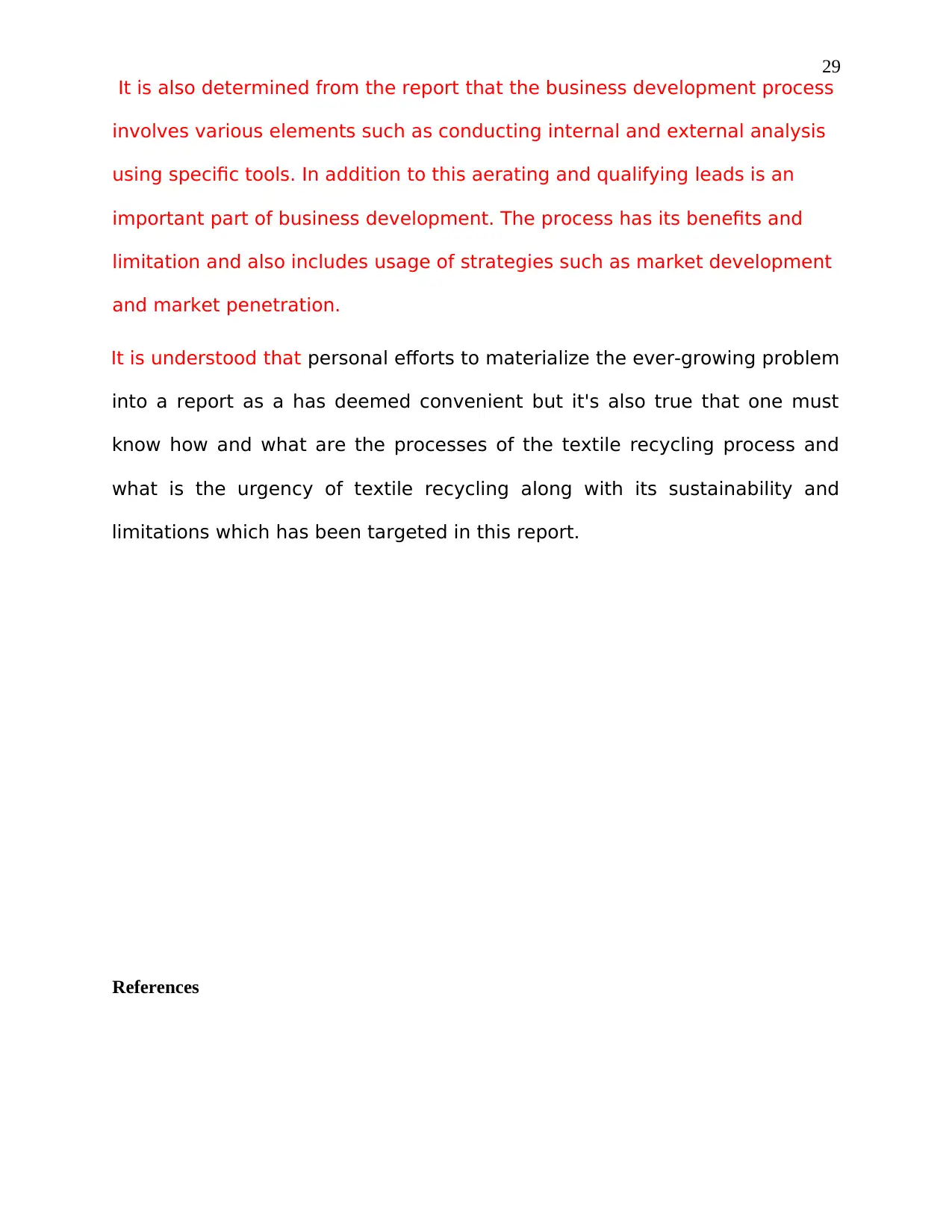
29
It is also determined from the report that the business development process
involves various elements such as conducting internal and external analysis
using specific tools. In addition to this aerating and qualifying leads is an
important part of business development. The process has its benefits and
limitation and also includes usage of strategies such as market development
and market penetration.
It is understood that personal efforts to materialize the ever-growing problem
into a report as a has deemed convenient but it's also true that one must
know how and what are the processes of the textile recycling process and
what is the urgency of textile recycling along with its sustainability and
limitations which has been targeted in this report.
References
It is also determined from the report that the business development process
involves various elements such as conducting internal and external analysis
using specific tools. In addition to this aerating and qualifying leads is an
important part of business development. The process has its benefits and
limitation and also includes usage of strategies such as market development
and market penetration.
It is understood that personal efforts to materialize the ever-growing problem
into a report as a has deemed convenient but it's also true that one must
know how and what are the processes of the textile recycling process and
what is the urgency of textile recycling along with its sustainability and
limitations which has been targeted in this report.
References
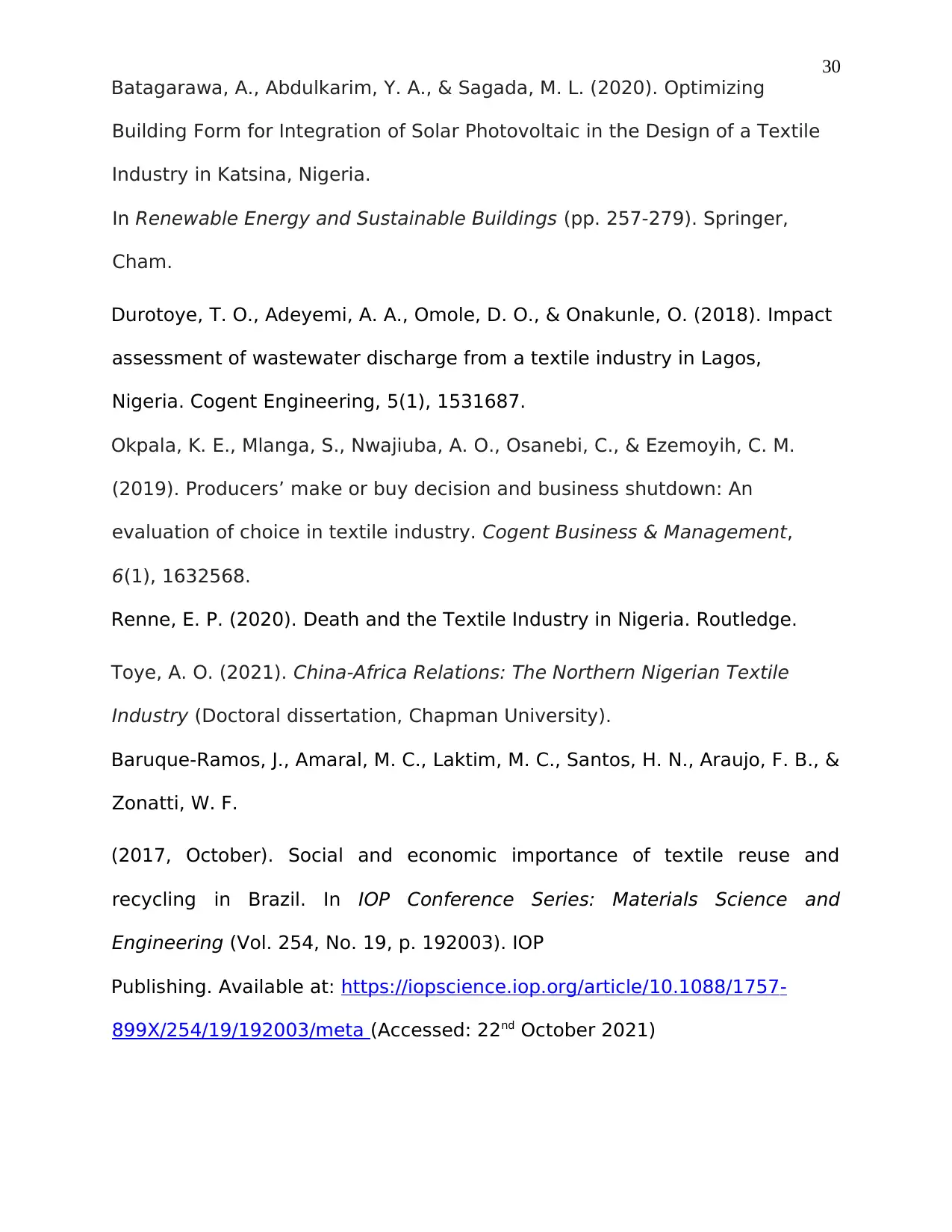
30
Batagarawa, A., Abdulkarim, Y. A., & Sagada, M. L. (2020). Optimizing
Building Form for Integration of Solar Photovoltaic in the Design of a Textile
Industry in Katsina, Nigeria.
In Renewable Energy and Sustainable Buildings (pp. 257-279). Springer,
Cham.
Durotoye, T. O., Adeyemi, A. A., Omole, D. O., & Onakunle, O. (2018). Impact
assessment of wastewater discharge from a textile industry in Lagos,
Nigeria. Cogent Engineering, 5(1), 1531687.
Okpala, K. E., Mlanga, S., Nwajiuba, A. O., Osanebi, C., & Ezemoyih, C. M.
(2019). Producers’ make or buy decision and business shutdown: An
evaluation of choice in textile industry. Cogent Business & Management,
6(1), 1632568.
Renne, E. P. (2020). Death and the Textile Industry in Nigeria. Routledge.
Toye, A. O. (2021). China-Africa Relations: The Northern Nigerian Textile
Industry (Doctoral dissertation, Chapman University).
Baruque-Ramos, J., Amaral, M. C., Laktim, M. C., Santos, H. N., Araujo, F. B., &
Zonatti, W. F.
(2017, October). Social and economic importance of textile reuse and
recycling in Brazil. In IOP Conference Series: Materials Science and
Engineering (Vol. 254, No. 19, p. 192003). IOP
Publishing. Available at: https://iopscience.iop.org/article/10.1088/1757-
899X/254/19/192003/meta (Accessed: 22nd October 2021)
Batagarawa, A., Abdulkarim, Y. A., & Sagada, M. L. (2020). Optimizing
Building Form for Integration of Solar Photovoltaic in the Design of a Textile
Industry in Katsina, Nigeria.
In Renewable Energy and Sustainable Buildings (pp. 257-279). Springer,
Cham.
Durotoye, T. O., Adeyemi, A. A., Omole, D. O., & Onakunle, O. (2018). Impact
assessment of wastewater discharge from a textile industry in Lagos,
Nigeria. Cogent Engineering, 5(1), 1531687.
Okpala, K. E., Mlanga, S., Nwajiuba, A. O., Osanebi, C., & Ezemoyih, C. M.
(2019). Producers’ make or buy decision and business shutdown: An
evaluation of choice in textile industry. Cogent Business & Management,
6(1), 1632568.
Renne, E. P. (2020). Death and the Textile Industry in Nigeria. Routledge.
Toye, A. O. (2021). China-Africa Relations: The Northern Nigerian Textile
Industry (Doctoral dissertation, Chapman University).
Baruque-Ramos, J., Amaral, M. C., Laktim, M. C., Santos, H. N., Araujo, F. B., &
Zonatti, W. F.
(2017, October). Social and economic importance of textile reuse and
recycling in Brazil. In IOP Conference Series: Materials Science and
Engineering (Vol. 254, No. 19, p. 192003). IOP
Publishing. Available at: https://iopscience.iop.org/article/10.1088/1757-
899X/254/19/192003/meta (Accessed: 22nd October 2021)
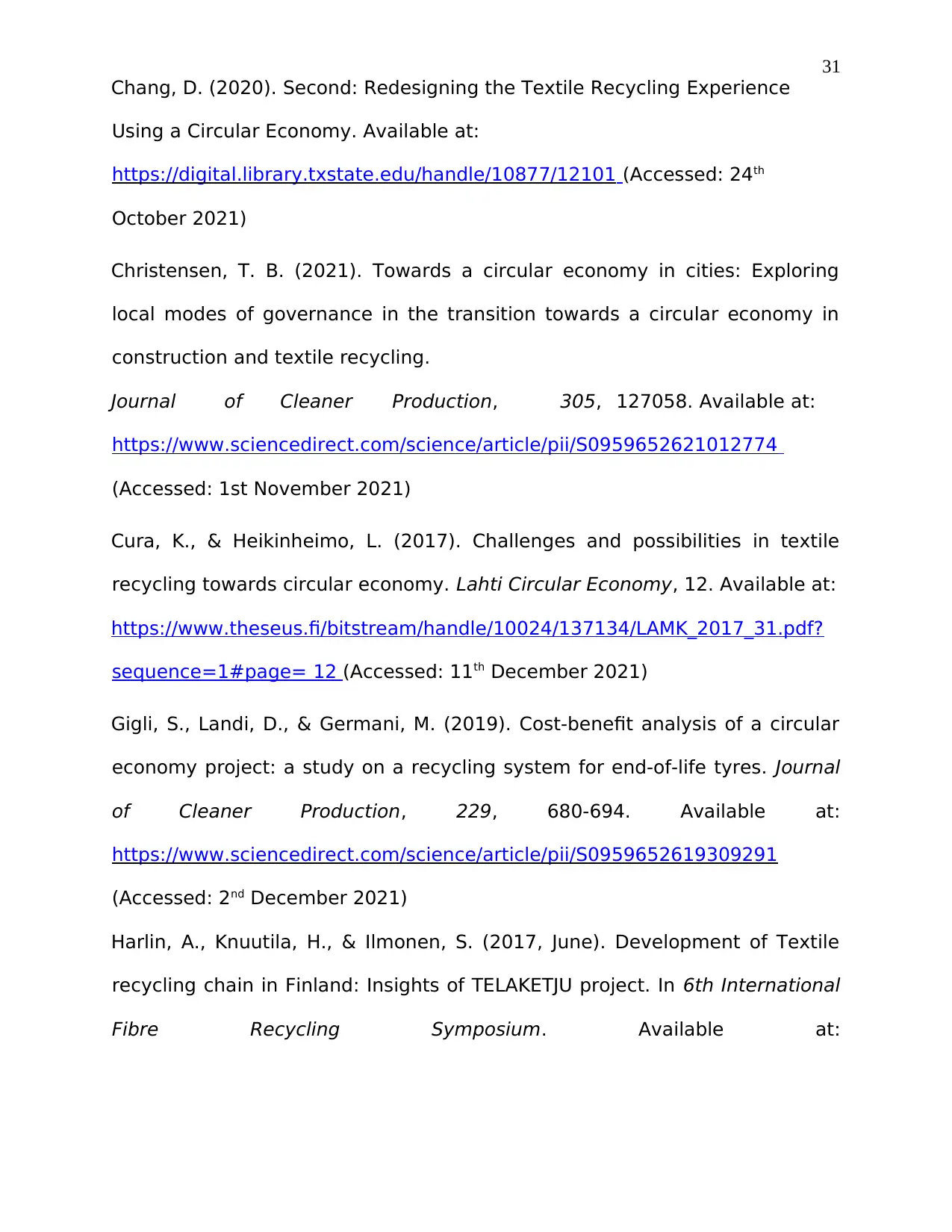
31
Chang, D. (2020). Second: Redesigning the Textile Recycling Experience
Using a Circular Economy. Available at:
https://digital.library.txstate.edu/handle/10877/12101 (Accessed: 24th
October 2021)
Christensen, T. B. (2021). Towards a circular economy in cities: Exploring
local modes of governance in the transition towards a circular economy in
construction and textile recycling.
Journal of Cleaner Production, 305, 127058. Available at:
https://www.sciencedirect.com/science/article/pii/S0959652621012774
(Accessed: 1st November 2021)
Cura, K., & Heikinheimo, L. (2017). Challenges and possibilities in textile
recycling towards circular economy. Lahti Circular Economy, 12. Available at:
https://www.theseus.fi/bitstream/handle/10024/137134/LAMK_2017_31.pdf?
sequence=1#page= 12 (Accessed: 11th December 2021)
Gigli, S., Landi, D., & Germani, M. (2019). Cost-benefit analysis of a circular
economy project: a study on a recycling system for end-of-life tyres. Journal
of Cleaner Production, 229, 680-694. Available at:
https://www.sciencedirect.com/science/article/pii/S0959652619309291
(Accessed: 2nd December 2021)
Harlin, A., Knuutila, H., & Ilmonen, S. (2017, June). Development of Textile
recycling chain in Finland: Insights of TELAKETJU project. In 6th International
Fibre Recycling Symposium. Available at:
Chang, D. (2020). Second: Redesigning the Textile Recycling Experience
Using a Circular Economy. Available at:
https://digital.library.txstate.edu/handle/10877/12101 (Accessed: 24th
October 2021)
Christensen, T. B. (2021). Towards a circular economy in cities: Exploring
local modes of governance in the transition towards a circular economy in
construction and textile recycling.
Journal of Cleaner Production, 305, 127058. Available at:
https://www.sciencedirect.com/science/article/pii/S0959652621012774
(Accessed: 1st November 2021)
Cura, K., & Heikinheimo, L. (2017). Challenges and possibilities in textile
recycling towards circular economy. Lahti Circular Economy, 12. Available at:
https://www.theseus.fi/bitstream/handle/10024/137134/LAMK_2017_31.pdf?
sequence=1#page= 12 (Accessed: 11th December 2021)
Gigli, S., Landi, D., & Germani, M. (2019). Cost-benefit analysis of a circular
economy project: a study on a recycling system for end-of-life tyres. Journal
of Cleaner Production, 229, 680-694. Available at:
https://www.sciencedirect.com/science/article/pii/S0959652619309291
(Accessed: 2nd December 2021)
Harlin, A., Knuutila, H., & Ilmonen, S. (2017, June). Development of Textile
recycling chain in Finland: Insights of TELAKETJU project. In 6th International
Fibre Recycling Symposium. Available at:
Paraphrase This Document
Need a fresh take? Get an instant paraphrase of this document with our AI Paraphraser
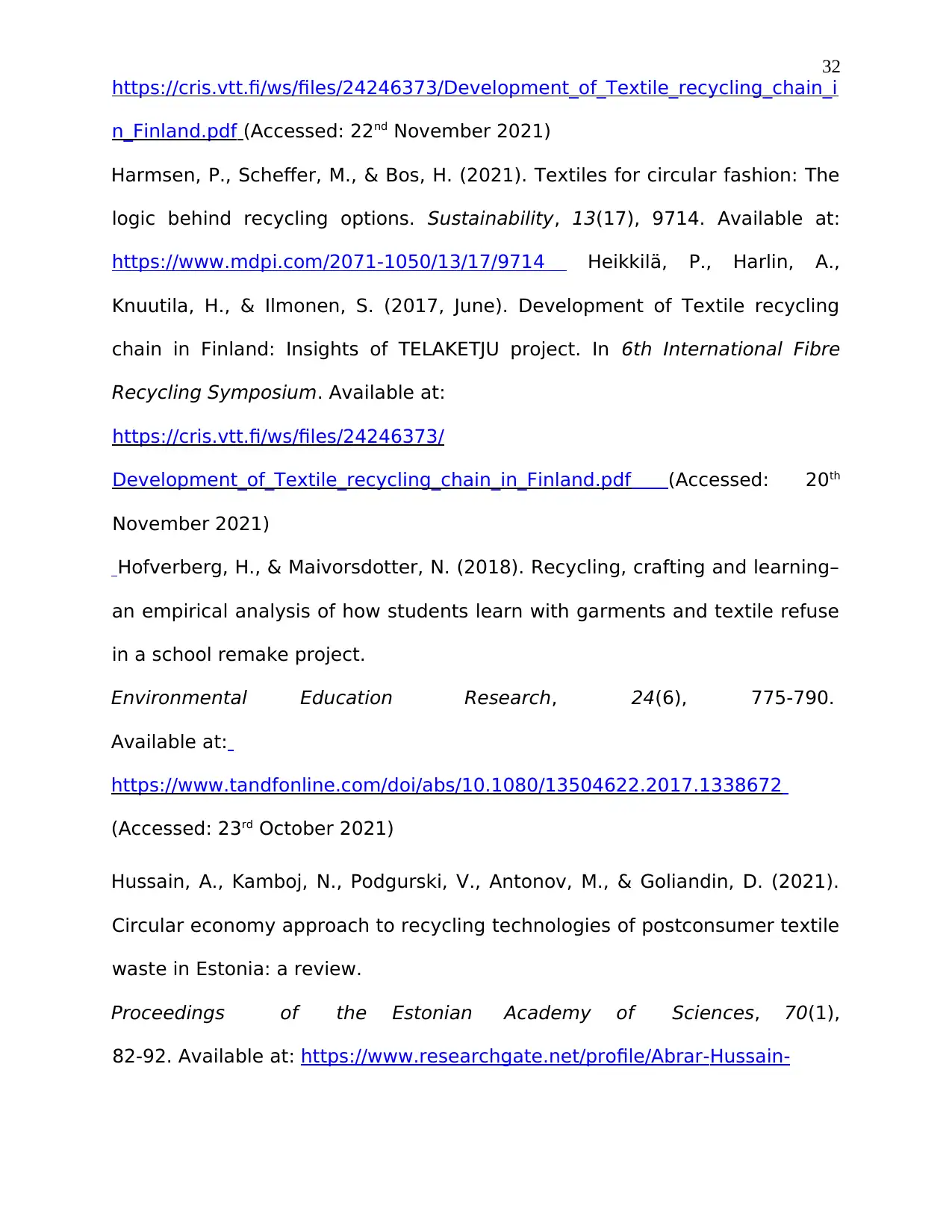
32
https://cris.vtt.fi/ws/files/24246373/Development_of_Textile_recycling_chain_i
n_Finland.pdf (Accessed: 22nd November 2021)
Harmsen, P., Scheffer, M., & Bos, H. (2021). Textiles for circular fashion: The
logic behind recycling options. Sustainability, 13(17), 9714. Available at:
https://www.mdpi.com/2071-1050/13/17/9714 Heikkilä, P., Harlin, A.,
Knuutila, H., & Ilmonen, S. (2017, June). Development of Textile recycling
chain in Finland: Insights of TELAKETJU project. In 6th International Fibre
Recycling Symposium. Available at:
https://cris.vtt.fi/ws/files/24246373/
Development_of_Textile_recycling_chain_in_Finland.pdf (Accessed: 20th
November 2021)
Hofverberg, H., & Maivorsdotter, N. (2018). Recycling, crafting and learning–
an empirical analysis of how students learn with garments and textile refuse
in a school remake project.
Environmental Education Research, 24(6), 775-790.
Available at:
https://www.tandfonline.com/doi/abs/10.1080/13504622.2017.1338672
(Accessed: 23rd October 2021)
Hussain, A., Kamboj, N., Podgurski, V., Antonov, M., & Goliandin, D. (2021).
Circular economy approach to recycling technologies of postconsumer textile
waste in Estonia: a review.
Proceedings of the Estonian Academy of Sciences, 70(1),
82-92. Available at: https://www.researchgate.net/profile/Abrar-Hussain-
https://cris.vtt.fi/ws/files/24246373/Development_of_Textile_recycling_chain_i
n_Finland.pdf (Accessed: 22nd November 2021)
Harmsen, P., Scheffer, M., & Bos, H. (2021). Textiles for circular fashion: The
logic behind recycling options. Sustainability, 13(17), 9714. Available at:
https://www.mdpi.com/2071-1050/13/17/9714 Heikkilä, P., Harlin, A.,
Knuutila, H., & Ilmonen, S. (2017, June). Development of Textile recycling
chain in Finland: Insights of TELAKETJU project. In 6th International Fibre
Recycling Symposium. Available at:
https://cris.vtt.fi/ws/files/24246373/
Development_of_Textile_recycling_chain_in_Finland.pdf (Accessed: 20th
November 2021)
Hofverberg, H., & Maivorsdotter, N. (2018). Recycling, crafting and learning–
an empirical analysis of how students learn with garments and textile refuse
in a school remake project.
Environmental Education Research, 24(6), 775-790.
Available at:
https://www.tandfonline.com/doi/abs/10.1080/13504622.2017.1338672
(Accessed: 23rd October 2021)
Hussain, A., Kamboj, N., Podgurski, V., Antonov, M., & Goliandin, D. (2021).
Circular economy approach to recycling technologies of postconsumer textile
waste in Estonia: a review.
Proceedings of the Estonian Academy of Sciences, 70(1),
82-92. Available at: https://www.researchgate.net/profile/Abrar-Hussain-
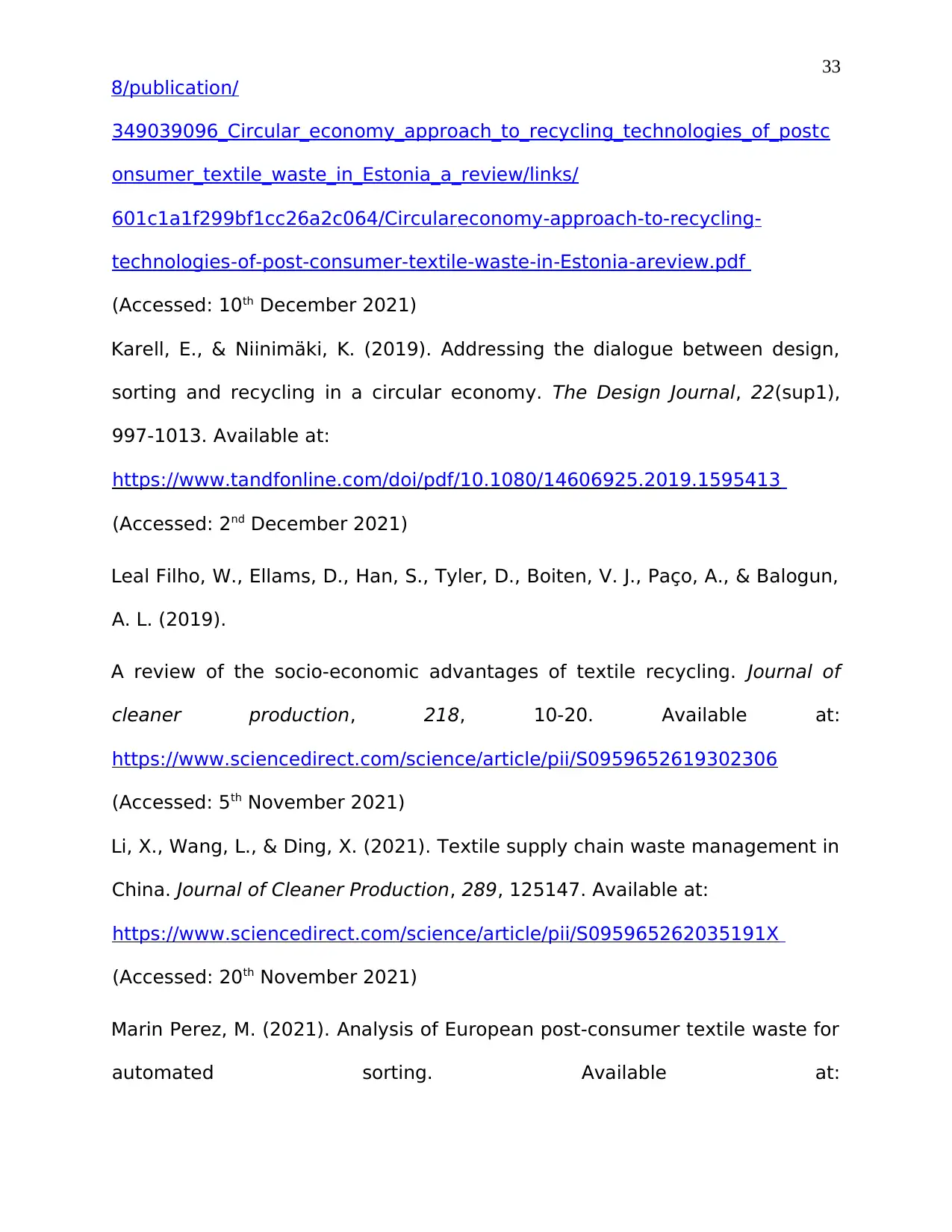
33
8/publication/
349039096_Circular_economy_approach_to_recycling_technologies_of_postc
onsumer_textile_waste_in_Estonia_a_review/links/
601c1a1f299bf1cc26a2c064/Circulareconomy-approach-to-recycling-
technologies-of-post-consumer-textile-waste-in-Estonia-areview.pdf
(Accessed: 10th December 2021)
Karell, E., & Niinimäki, K. (2019). Addressing the dialogue between design,
sorting and recycling in a circular economy. The Design Journal, 22(sup1),
997-1013. Available at:
https://www.tandfonline.com/doi/pdf/10.1080/14606925.2019.1595413
(Accessed: 2nd December 2021)
Leal Filho, W., Ellams, D., Han, S., Tyler, D., Boiten, V. J., Paço, A., & Balogun,
A. L. (2019).
A review of the socio-economic advantages of textile recycling. Journal of
cleaner production, 218, 10-20. Available at:
https://www.sciencedirect.com/science/article/pii/S0959652619302306
(Accessed: 5th November 2021)
Li, X., Wang, L., & Ding, X. (2021). Textile supply chain waste management in
China. Journal of Cleaner Production, 289, 125147. Available at:
https://www.sciencedirect.com/science/article/pii/S095965262035191X
(Accessed: 20th November 2021)
Marin Perez, M. (2021). Analysis of European post-consumer textile waste for
automated sorting. Available at:
8/publication/
349039096_Circular_economy_approach_to_recycling_technologies_of_postc
onsumer_textile_waste_in_Estonia_a_review/links/
601c1a1f299bf1cc26a2c064/Circulareconomy-approach-to-recycling-
technologies-of-post-consumer-textile-waste-in-Estonia-areview.pdf
(Accessed: 10th December 2021)
Karell, E., & Niinimäki, K. (2019). Addressing the dialogue between design,
sorting and recycling in a circular economy. The Design Journal, 22(sup1),
997-1013. Available at:
https://www.tandfonline.com/doi/pdf/10.1080/14606925.2019.1595413
(Accessed: 2nd December 2021)
Leal Filho, W., Ellams, D., Han, S., Tyler, D., Boiten, V. J., Paço, A., & Balogun,
A. L. (2019).
A review of the socio-economic advantages of textile recycling. Journal of
cleaner production, 218, 10-20. Available at:
https://www.sciencedirect.com/science/article/pii/S0959652619302306
(Accessed: 5th November 2021)
Li, X., Wang, L., & Ding, X. (2021). Textile supply chain waste management in
China. Journal of Cleaner Production, 289, 125147. Available at:
https://www.sciencedirect.com/science/article/pii/S095965262035191X
(Accessed: 20th November 2021)
Marin Perez, M. (2021). Analysis of European post-consumer textile waste for
automated sorting. Available at:
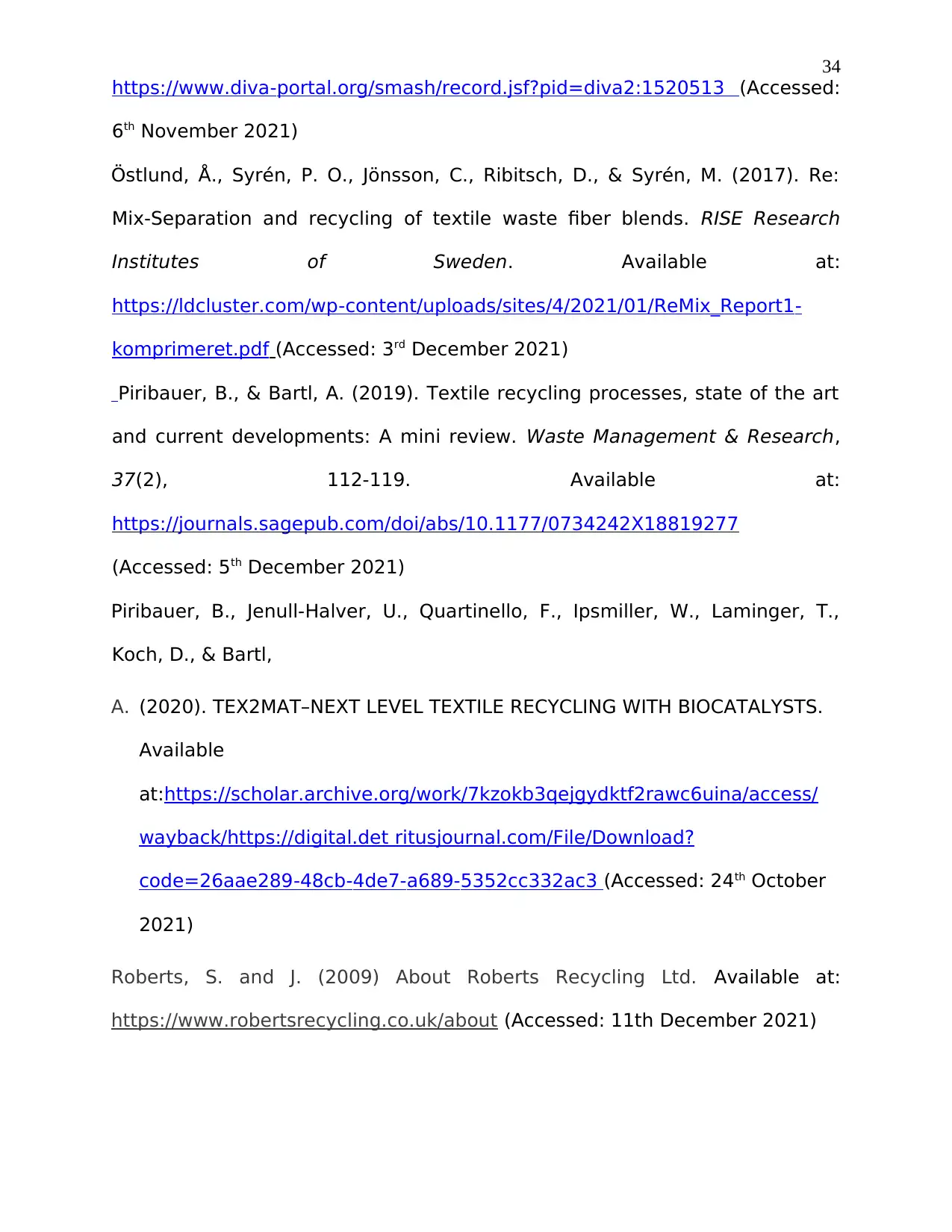
34
https://www.diva-portal.org/smash/record.jsf?pid=diva2:1520513 (Accessed:
6th November 2021)
Östlund, Å., Syrén, P. O., Jönsson, C., Ribitsch, D., & Syrén, M. (2017). Re:
Mix-Separation and recycling of textile waste fiber blends. RISE Research
Institutes of Sweden. Available at:
https://ldcluster.com/wp-content/uploads/sites/4/2021/01/ReMix_Report1-
komprimeret.pdf (Accessed: 3rd December 2021)
Piribauer, B., & Bartl, A. (2019). Textile recycling processes, state of the art
and current developments: A mini review. Waste Management & Research,
37(2), 112-119. Available at:
https://journals.sagepub.com/doi/abs/10.1177/0734242X18819277
(Accessed: 5th December 2021)
Piribauer, B., Jenull-Halver, U., Quartinello, F., Ipsmiller, W., Laminger, T.,
Koch, D., & Bartl,
A. (2020). TEX2MAT–NEXT LEVEL TEXTILE RECYCLING WITH BIOCATALYSTS.
Available
at:https://scholar.archive.org/work/7kzokb3qejgydktf2rawc6uina/access/
wayback/https://digital.det ritusjournal.com/File/Download?
code=26aae289-48cb-4de7-a689-5352cc332ac3 (Accessed: 24th October
2021)
Roberts, S. and J. (2009) About Roberts Recycling Ltd. Available at:
https://www.robertsrecycling.co.uk/about (Accessed: 11th December 2021)
https://www.diva-portal.org/smash/record.jsf?pid=diva2:1520513 (Accessed:
6th November 2021)
Östlund, Å., Syrén, P. O., Jönsson, C., Ribitsch, D., & Syrén, M. (2017). Re:
Mix-Separation and recycling of textile waste fiber blends. RISE Research
Institutes of Sweden. Available at:
https://ldcluster.com/wp-content/uploads/sites/4/2021/01/ReMix_Report1-
komprimeret.pdf (Accessed: 3rd December 2021)
Piribauer, B., & Bartl, A. (2019). Textile recycling processes, state of the art
and current developments: A mini review. Waste Management & Research,
37(2), 112-119. Available at:
https://journals.sagepub.com/doi/abs/10.1177/0734242X18819277
(Accessed: 5th December 2021)
Piribauer, B., Jenull-Halver, U., Quartinello, F., Ipsmiller, W., Laminger, T.,
Koch, D., & Bartl,
A. (2020). TEX2MAT–NEXT LEVEL TEXTILE RECYCLING WITH BIOCATALYSTS.
Available
at:https://scholar.archive.org/work/7kzokb3qejgydktf2rawc6uina/access/
wayback/https://digital.det ritusjournal.com/File/Download?
code=26aae289-48cb-4de7-a689-5352cc332ac3 (Accessed: 24th October
2021)
Roberts, S. and J. (2009) About Roberts Recycling Ltd. Available at:
https://www.robertsrecycling.co.uk/about (Accessed: 11th December 2021)
Secure Best Marks with AI Grader
Need help grading? Try our AI Grader for instant feedback on your assignments.
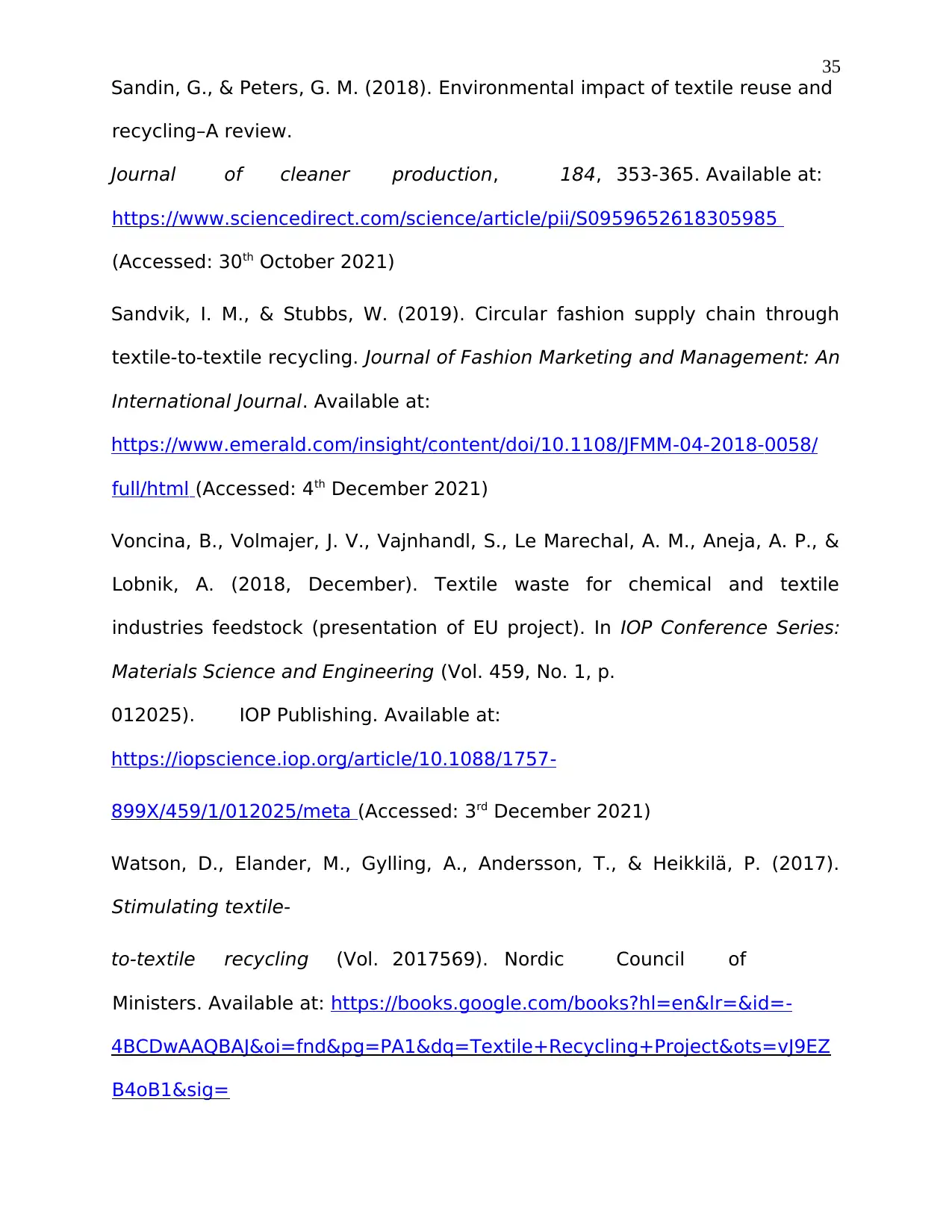
35
Sandin, G., & Peters, G. M. (2018). Environmental impact of textile reuse and
recycling–A review.
Journal of cleaner production, 184, 353-365. Available at:
https://www.sciencedirect.com/science/article/pii/S0959652618305985
(Accessed: 30th October 2021)
Sandvik, I. M., & Stubbs, W. (2019). Circular fashion supply chain through
textile-to-textile recycling. Journal of Fashion Marketing and Management: An
International Journal. Available at:
https://www.emerald.com/insight/content/doi/10.1108/JFMM-04-2018-0058/
full/html (Accessed: 4th December 2021)
Voncina, B., Volmajer, J. V., Vajnhandl, S., Le Marechal, A. M., Aneja, A. P., &
Lobnik, A. (2018, December). Textile waste for chemical and textile
industries feedstock (presentation of EU project). In IOP Conference Series:
Materials Science and Engineering (Vol. 459, No. 1, p.
012025). IOP Publishing. Available at:
https://iopscience.iop.org/article/10.1088/1757-
899X/459/1/012025/meta (Accessed: 3rd December 2021)
Watson, D., Elander, M., Gylling, A., Andersson, T., & Heikkilä, P. (2017).
Stimulating textile-
to-textile recycling (Vol. 2017569). Nordic Council of
Ministers. Available at: https://books.google.com/books?hl=en&lr=&id=-
4BCDwAAQBAJ&oi=fnd&pg=PA1&dq=Textile+Recycling+Project&ots=vJ9EZ
B4oB1&sig=
Sandin, G., & Peters, G. M. (2018). Environmental impact of textile reuse and
recycling–A review.
Journal of cleaner production, 184, 353-365. Available at:
https://www.sciencedirect.com/science/article/pii/S0959652618305985
(Accessed: 30th October 2021)
Sandvik, I. M., & Stubbs, W. (2019). Circular fashion supply chain through
textile-to-textile recycling. Journal of Fashion Marketing and Management: An
International Journal. Available at:
https://www.emerald.com/insight/content/doi/10.1108/JFMM-04-2018-0058/
full/html (Accessed: 4th December 2021)
Voncina, B., Volmajer, J. V., Vajnhandl, S., Le Marechal, A. M., Aneja, A. P., &
Lobnik, A. (2018, December). Textile waste for chemical and textile
industries feedstock (presentation of EU project). In IOP Conference Series:
Materials Science and Engineering (Vol. 459, No. 1, p.
012025). IOP Publishing. Available at:
https://iopscience.iop.org/article/10.1088/1757-
899X/459/1/012025/meta (Accessed: 3rd December 2021)
Watson, D., Elander, M., Gylling, A., Andersson, T., & Heikkilä, P. (2017).
Stimulating textile-
to-textile recycling (Vol. 2017569). Nordic Council of
Ministers. Available at: https://books.google.com/books?hl=en&lr=&id=-
4BCDwAAQBAJ&oi=fnd&pg=PA1&dq=Textile+Recycling+Project&ots=vJ9EZ
B4oB1&sig=
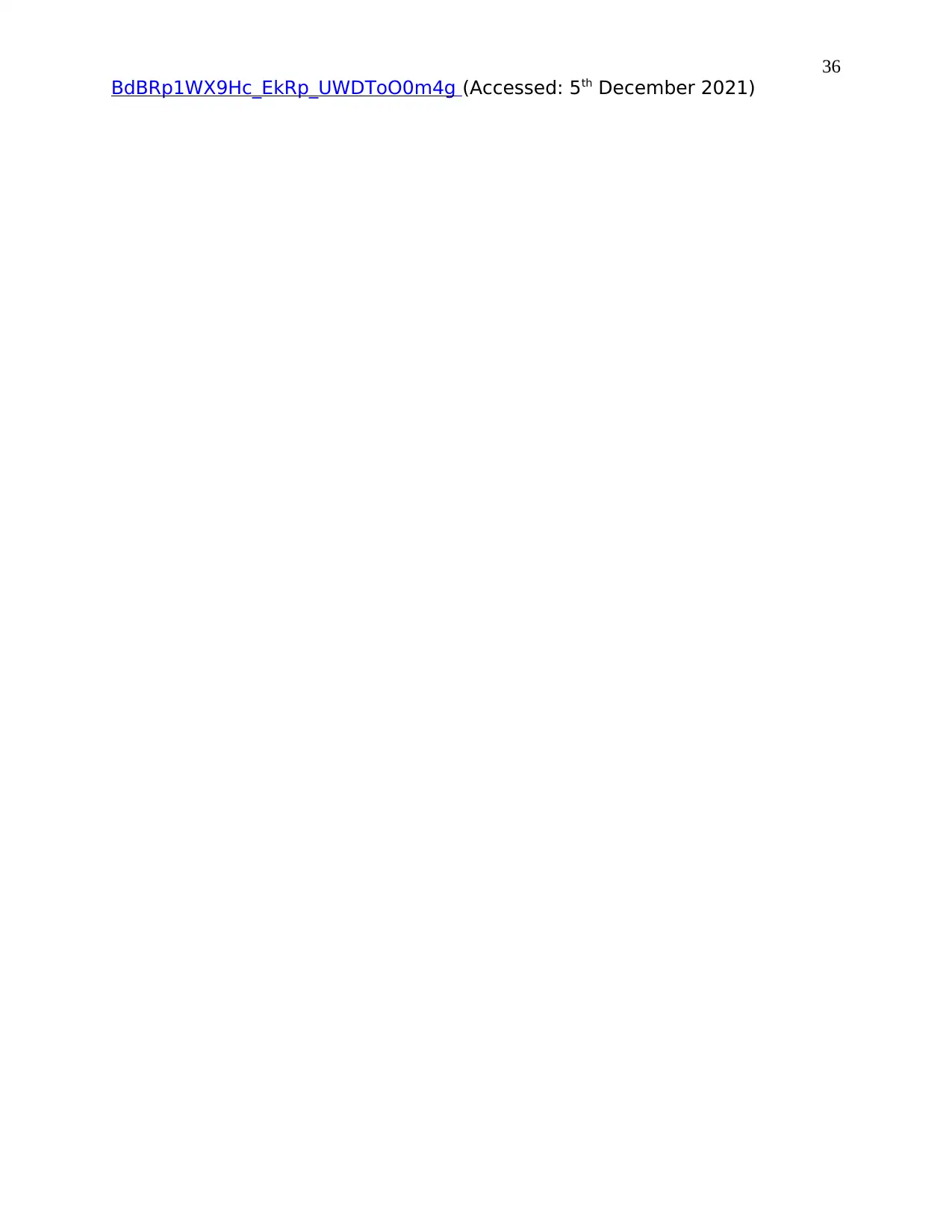
36
BdBRp1WX9Hc_EkRp_UWDToO0m4g (Accessed: 5th December 2021)
BdBRp1WX9Hc_EkRp_UWDToO0m4g (Accessed: 5th December 2021)
1 out of 36
Your All-in-One AI-Powered Toolkit for Academic Success.
+13062052269
info@desklib.com
Available 24*7 on WhatsApp / Email
![[object Object]](/_next/static/media/star-bottom.7253800d.svg)
Unlock your academic potential
© 2024 | Zucol Services PVT LTD | All rights reserved.